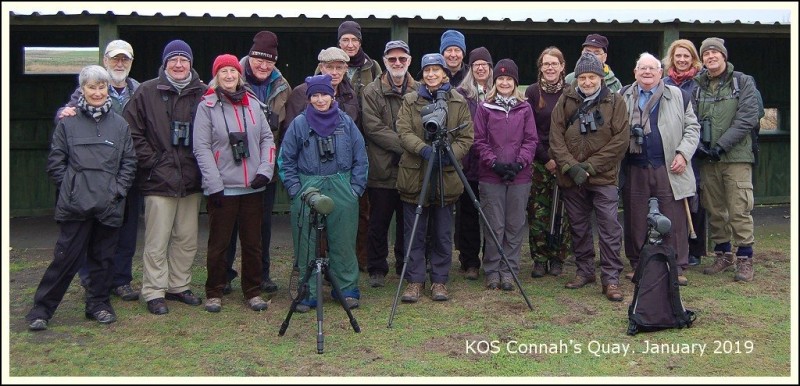|
Archived Latest News - 2019
Old KOS Bird Reports. Updated 31st December 2019 Bob Groom spent some time in Tatton's Allen hide on Sunday (29th) - Stonechat nr. Melchett Mere, also 7 Cormorants, Heron, Green Woodpecker... also an awful lot of people, Allen Hide full at one point (but all casual visitors enjoying the sun and the silence). I can't remember who it was, So the Witton Bridge car park was choc-a-bloc yesterday morning when we arrived for our traditional Christmas walk. Not being inclined to join the crowds of folk up on the embankment looking for the rarity - we'd take our chance on our return, if it was still there - we set off on the normal route up to Haydyn's Pool. The weather was beautiful, around 5
°
C and not a cloud in the sky, great conditions and a couple of Reed Buntings duly obliged, posing nicely for all our group (of 14 members today) to enjoy prolonged views and for Simon our photographer extraordinaire to get the cracking image shown on the left! A Peregrine was resting on one of the distant chimneys, as viewed from Haydn's, but the area in front of the hide is now overgrown and we rarely see anything of note from the hide. There's apparently not much that can be done to improve the situation, as they are down to a single Ranger and a small group of volunteers, who must see to more important tasks which use up the available resources. Ken and Shirley Davies have been off on one of their campervan trips again and recently visited the RSPB's Frampton Marsh reserve........ "a rather belated report on our recent visit to RSPB Frampton Marsh near Boston Lincolnshire , the weather was a little cloudy but thankfully not much wind. Some dates for your diary Friday 3rd January - CAWOS - "BEYOND 66.5 DEGREES NORTH - ARCTIC NORWAY" by Richard Steel Saturday 11th January - KOS - Burton Mere Wetlands RSPB - field trip, meet in Lilac Avenue, Knutsford 9am Leader: Bob Groom. Sunday 19th January - Winter Birdwatch, Allen Hide, Tatton Park 11am to 1pm. Joint venture with Darren Morris, Tatton Park Ranger. Leader: Frank Dearden. Friday 24th January KOS indoor meeting - 'Land of Contrasts - Namibia' by Keith Offord Saturday 25th January 11am until noon - RSPB Big Garden Birdwatch with the friends of Knutsford Moor,Sunday 26th January 11am until noon - RSPB Big Garden Birdwatch with the friends of Knutsford Heath, Finally, the 2018 Rostherne Mere report has now been made available. It's a splendid publication and well worth a read. You can download a FREE copy by clicking here here.
 13,000; I couldn't find anyone with less than our 38 members! So a turnout of 27 for the Christmas party on Friday, representing 71% of the total membership was very encouraging. It was a most successful evening, the buffet was exceptional this year with members providing, mostly homemade, food - ranging from my simple jacket potatoes to complex examples of culinary art - meat and vegetarian chilli, creme brulee and a delicious pavlova that vanished so fast the usual suspects were denied a second helping! The Hon. sec. kept the evening on track and, in his own inimitable manner, managed to squeeze a few more quid out of members during the final auction. Len Mason won the quiz this year, mainly due to his knowledge of the topography of our Cheshire meres and the following day, Hon. Treasurer Frank told us that we made a record profit of
£400. Well done everyone - a great team effort that will keep us in speakers for another 12 months! 13,000; I couldn't find anyone with less than our 38 members! So a turnout of 27 for the Christmas party on Friday, representing 71% of the total membership was very encouraging. It was a most successful evening, the buffet was exceptional this year with members providing, mostly homemade, food - ranging from my simple jacket potatoes to complex examples of culinary art - meat and vegetarian chilli, creme brulee and a delicious pavlova that vanished so fast the usual suspects were denied a second helping! The Hon. sec. kept the evening on track and, in his own inimitable manner, managed to squeeze a few more quid out of members during the final auction. Len Mason won the quiz this year, mainly due to his knowledge of the topography of our Cheshire meres and the following day, Hon. Treasurer Frank told us that we made a record profit of
£400. Well done everyone - a great team effort that will keep us in speakers for another 12 months!Predictably, fewer people met up on a cold and drizzly Sunday morning (15th) for our December field trip up to Marshside and Martin Mere. Just 4
°
C as we arrived at Marshside, although the rain had stopped and overnight snow on the distant Pennine hills provided a beautiful Winter backdrop, against which the silhouettes of flocks of Pink-footed Geese were a fine sight as they passed out towards the Ribble estuary. The admission price for adult non-members at Martin mere is now
£
13.00 and a still a hefty
£
11.04 for concessionary entry - I think they're pushing their luck a little with those prices, especially as the area of pens containing the collection of wildfowl from various parts of the world seems to have been neglected over recent times and isn't a patch on what it was in the past. On Monday 30th December we'll be doing what is now our traditional post-Christmas walk around the Northwich Woodlands (Neumann's, Haydn Pool, Budworth Mere etc.) meeting at 10:00am at the usual Witton Bridge car park. So, to all KOS members and any others who happen to pass this way - have a happy and peaceful Christmas and, if we don't see you on the Christmas walk, best wishes for a happy and healthy new year.
Not quite on a par with the discovery of the Dead Sea Scrolls but nevertheless I was delighted in the week when Len Mason unearthed a copy of our KOS 1980 Bird Report - the final piece in a jigsaw I thought would never be completed! I'd previously obtained copies of the others and published them on this website but had almost given up hope of locating a copy of the final one, edited by Barrie Armitt. It's probably the best of the lot - accurate and well-written by someone who went on to gain a degree in English Literature from the University of Newcastle and spend many years teaching the subject in inner city Liverpool! Being A5 in size it wasn't as easy to reproduce as the others which are all A4; I had to scan the report as a jpeg image, turn it through 90 degrees and convert it to a pdf (I know, there are probably better ways of doing it!) anyway it's not too bad, except that some of the lower case letter "s" are reproduced as "n" - Barrie wouldn't have allows this in the original. He'd added many records from preceding years that had been missed and been meticulous in the spelling of the scientific bird names! Looking at the list of speakers, even after all these years I can remember some of them. Who can forget GMP police officer Emrys Edwards and his talk "Birds Eye View" and, of course, the legendary Eric Hardy and his "Birds of the Highlands"!! Here are the reports. 1974...1975...1976...1977...1978...1980 It was a damp, wet morning on Wednesday (27th) when we headed over to Warrington and the Woolston Eyes reserve. The Hon.Sec. said that it would be a day for socialising and not birds. He was right. A ring-tailed Hen Harrier had been seen earlier in the morning but there was no sign of it; in fact we didn't see any raptors during the time we were there. A feeding station has been set up in front of the Sybil Hogg hide and was attracting a fair collection of species, mainly Blue, Great and Coal Tits. Nearby, feeding in the phragmites reeds we'd watched a Reed Bunting and, surprisingly, a Goldcrest keeping very close company - a very odd couple. We ended up with just 32 species, not the best of mornings but a good team building exercise! Next Friday (6th December) it's the final CAWOS indoor meeting of the year when Keith Offord will be giving a talk entitled "An Indian Winter" 7:45pm at St. Vincent's Church in Tatton Street. The following week is the big one of course and on Friday 13th it's our KOS Christmas party, from 7:00pm in the Jubilee Hall (for members who will be providing food) and 7:30 or thereabouts for everyone else. Admission this year is £ 8 and this includes food from the buffet - you'll not get better value from any of the town's restaurants over the Christmas period!!
Just one degree above freezing yesterday (Mon.18th) as I arrived for a morning's birding at Rostherne, unbroken sunshine though and a balmy 6C in the obs., wasn't there once a heater in there? I was joined by Tony Mossman and John Cowling, two characters from the Stockport Birdwatching Society, an organisation still going strong and who are lucky enough to have sufficent members 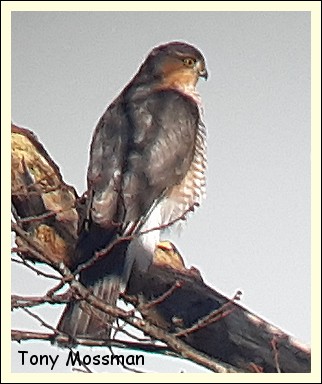 for monthly coach trips to various locations. I notice on their blog that last month's was all the way up to Saltholme; that's a heck of a journey in a single day! Stockport Birdwatching Society. for monthly coach trips to various locations. I notice on their blog that last month's was all the way up to Saltholme; that's a heck of a journey in a single day! Stockport Birdwatching Society.All quiet at first, but after a short time there appeared to be some sort of disturbance and the waterfowl became quite agitated, revealing that there were many more present than appeared at first glance. Amongst others we counted 2 Egyptian Geese, 4 Goosanders, 7 Goldeneye and no less than 40 Mandarin Ducks. One of the resident Kestrels put in a brief appearance but a fine little male Sparrowhawk perched for some time in the "split limes" giving Tony time to get the record shot shown, using his 'scope and phone camera. Bob Groom had been doing his monthly wildfowl count at Tabley but arrived in time to see the Sparrowhawk that we were admiring, but he'd gone one better and had encountered a Goshawk at Tabley!! Wintering Whooper Swans have appeared in our area; the Rostherne log contained details of two recent sightings - 16 circled the mere on the 15th and 8 landed briefly two days later. These weren't the first though, the honour this Winter goes to Tatton where Bob (who else!) had 3 last Tuesday (12th) The same observer paid another visit to the park last Friday (15th) and was suitably rewarded.........Zipped in P.M. The whoopers had gone but several rewards. A handsome drake Pintail close in, 5 Wigeon and a female Goldeneye which, unusually, hauled out on the near bank to sunbathe with the Mallard, though it was wary of them. At least 80 Snipe flew up, and round, as a Buzzard cruised low over the boggy area. It perched briefly on the dead tree. Once it had gone there was some repositioning by some of the snipe. A Little Grebe also put in an appearance. Well done Bob, keep up the good work!This Friday it's our monthly indoor get together when our own KOS member and Cheshire County Recorder Hugh Pulsford will be telling us about his encounter with "Snow Leopards in NW India". Usual time and place - 7:45pm in the Jubilee Hall. 12/11/2019...... North Wales As I've said before, we're always reluctant to change the date of a field trip, but the weather forecast for Saturday (9th) was so bad that the planned KOS field trip to North Wales was re-arranged for the following day (10th). It turned out that this was a wise decision, as local residents at Llanfairfechan told us that Saturday had been a thoroughly unpleasant day. Unfortunately swapping days meant that some people who had planned to travel on the Saturday couldn't make Sunday, nevertheless a group of eleven were able to attend and met up on the promenade at 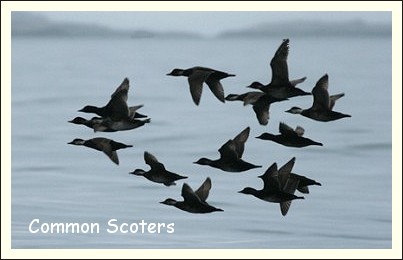 Llanfairfechan for a 10:30am start. Llanfairfechan for a 10:30am start.Driving down the A55 North Wales Expressway the results of the previous day's weather were much in evidence with a layer of snow covering the hills as we descended towards St. Asaph - described as Alpine scenery by one member of the party! Down at sea level it was quite cool, only 6 ° C but there was little wind and unbroken sunshine made it a very pleasant morning. The first job of the day was a little bit of sea watching, scope's were set up and 15 minutes or so were spent scanning what at this point is the start of the Menai Strait. The most obvious birds were Oystercatchers with long strings passing up towards Bangor, but they were probably outnumbered by Common Scoters, further out and more difficult to pick out, but seemingly present in huge numbers. We always understood that the distance from Llanfairfechan to the Morfa Madryn nature reserve was one mile; it always seemed longer to me so I used my phone app. on Sunday to accurately measure how far we walked and can report that it's a round trip of 5.16 Km or 3.2 miles! We had just about all the expected species - Little Egret, Curlew, Snipe, Teal, Wigeon, Meadow Pipit, Skylark and Linnet on our way to reserve but a Stonechat seen by two members was a nice bonus. The reserve was quieter than in previous years with just two Lapwings, (7.4% of the Welsh population nest at Madryn), and an adult male Goosander with two female/immature companions. The small stream that empties into the sea close to the car park at Llanfairfechan is named Afon Llanfairfechan, it's a favourite spot for Dipper, and one duly appeared just below the bridge as we trudged back for lunch, which was enjoyed on the benches overlooking the sea before we moved on to the RSPB Reserve at Conwy. We'd spent longer than expected at Llanfairfechan and decided not to do the full circuit at Conwy but restrict ourselves to the first few hides overlooking the fresh water pools. Nevertheless they were quite productive and allowed us to add species such as Gadwall, Water Rail, Shoveler, Little Grebe, Goldeneye and Sparrowhawk to the day list giving us a creditable final tally of 60.
A mixed flock of c.80 Redwings and Fieldfares this morning over Pavement Lane in Mobberley, there seems to have been an influx over the past few days with calm clear weather and an easterly wind to assist migration. 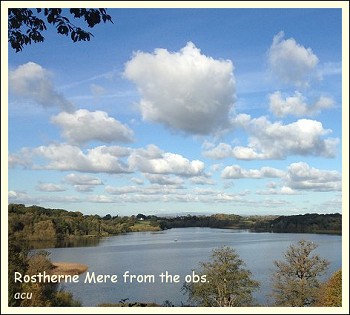 These weren't my first Fieldfares though; on Monday (28/10) Bob Groom and I went over to Rostherne for a couple of hours birding and had a flock of about 100 Fieldfares, high over the reserve heading in a westerly direction. It was a beautiful morning, just 10
°
C, blue sky with a scattering of cumulus clouds drifting slowly past. The reserve's first Bittern of the season had been seen the previous day from the appropriately named Bittern Hide! There was no sign of this bird from the obs. but we were kept quite busy with seven Buzzards in the air at the same time, two Sparrowhawks, a big female and a smaller male, which we took to be a pair, performed aerobatics over Harper's Bank wood and the resident pair of Kestrels weren't straying far from this years nest site in an old alder tree next to the boathouse. They may have competition though as the local Jackdaws have been showing an unhealthy interest in the same location - it should be interesting next spring! On the mere itself we counted 50 Greylag Geese, 7 Goldeneye and 2 Egyptian geese flew in from the direction of Tatton Park. These weren't my first Fieldfares though; on Monday (28/10) Bob Groom and I went over to Rostherne for a couple of hours birding and had a flock of about 100 Fieldfares, high over the reserve heading in a westerly direction. It was a beautiful morning, just 10
°
C, blue sky with a scattering of cumulus clouds drifting slowly past. The reserve's first Bittern of the season had been seen the previous day from the appropriately named Bittern Hide! There was no sign of this bird from the obs. but we were kept quite busy with seven Buzzards in the air at the same time, two Sparrowhawks, a big female and a smaller male, which we took to be a pair, performed aerobatics over Harper's Bank wood and the resident pair of Kestrels weren't straying far from this years nest site in an old alder tree next to the boathouse. They may have competition though as the local Jackdaws have been showing an unhealthy interest in the same location - it should be interesting next spring! On the mere itself we counted 50 Greylag Geese, 7 Goldeneye and 2 Egyptian geese flew in from the direction of Tatton Park.Friday's indoor meeting went very well when an audience of 25 welcomed a new speaker, Holly Page, who told us all about her "Natural Obsession" - which of course was natural history, especially birds - she's a bit of a self-confessed twitcher with her various lists held on a spreadsheet! She's only young and I think she'll grow out of it!! Her images were first class, her enthusiasm self-evident and we wish her good luck for the future, as she's moving to Scotland and will be working as a birding guide with the Heatherlea Birding & Wildlife Holiday company. Tomorrow evening (Friday 1st November) it's the turn of CAWOS [The Cheshire and Wirral Ornithological Society] who will be meeting in St. Vincent's church on Tatton Street for their monthly meeting. 22/10/2019......Lunt Meadows
A good turnout of 14 members, ably lead by Sue Middleton, 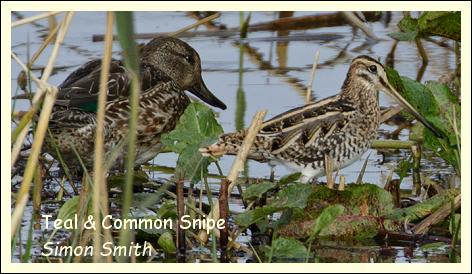 our trip leader for the day, gathered in the car park; initially the weather was just about perfect, blue skies with a few whispery clouds but quite a cool, light northerly wind and I noticed that most people had taken the precaution of bringing along some gloves! our trip leader for the day, gathered in the car park; initially the weather was just about perfect, blue skies with a few whispery clouds but quite a cool, light northerly wind and I noticed that most people had taken the precaution of bringing along some gloves!Walking towards the viewing screen overlooking the main pool there was plenty of activity with birds constantly in the air - Pink-footed Geese, Teal, Starlings and Common Snipe were the most obvious species but Skylarks and Meadow Pipits passed over in small numbers throughout the morning [click here for a map of the reserve] This Friday 25th we welcome a new speaker, Holly Page, to the Jubilee Hall for the October get together. 7:45pm for an 8pm start.
Redwings have arrived in good numbers and are helping themselves to a plentiful supply of Autumn berries, but of course these are the lucky ones, many don't survive the perilous journey across the North Sea. Malcolm Calvert recently witnessed this annual drama at first hand as he returned from a European cruise. Autumn migration by assisted passage MS Balmoral of Fred Olsen cruise line departed Bremen during the evening of 4 October 2019 en route to Port of Tyne, returning from a German Waterways cruise. During the early morning of 5 October it became apparent that many migratory birds were onboard as the vessel crossed the North Sea. Prevalent were Redwings, Goldcrests and Song Thrushes with each species numbering 20 or more. Throughout the day further species came into view: 8 Bramblings, 4 Robins, 4 Starlings, 3 Chiffchaffs, 2 Willow Warblers, 3 Meadow Pipits, 2 Wrens and a Blackcap. Whereas the passerines scuttled about the decks, often in proximity to passengers, a Ringed Plover preferred the quieter parts of the upper decks. A Jack Snipe and a Dunlin took refuge amongst the items of machinery on the bow. Sadly, there were a few fatalities with Song Thrushes and Goldcrests flying into the side windows of promenade deck in reflected sunlight. A hapless Song Thrush dropped on to the sea in the ship's wake some one hundred yards short of reaching the vessel. The wind was around force 4 south-south east for most of the day; air temperature of 12 ° C was recorded at noon with partly cloudy skies. Malcolm Calvert
13/10/2019...... First and Last Considering the amount of fieldwork he puts in, it was fitting that Bob Groom's Hobby record at Rostherne on the 5th seems to have been the final sighting of what's been an excellent year for the species. Nature doesn't stand still though and no sooner had the last Hobby headed south than the first Redwings of the autumn arrived in our area with a flock of about 50 feeding 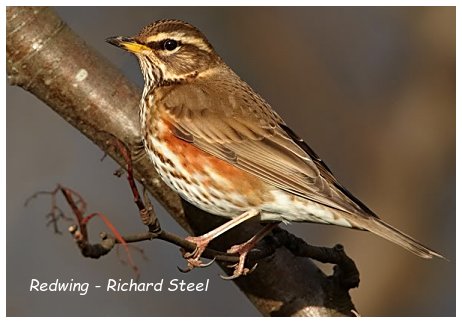 in yew trees in the centre of Rostherne village the next day; there'd been sightings the previous day at Woolston together with a few Fieldfares - all anxious to leave Europe before the October 31st deadline perhaps! in yew trees in the centre of Rostherne village the next day; there'd been sightings the previous day at Woolston together with a few Fieldfares - all anxious to leave Europe before the October 31st deadline perhaps!Both obvious species, but more subtle movements are always taking place; Bob had several Song Thrushes and 12 Mistle Thrushes on Thursday (10th), also at Rostherne and on Tuesday (8th) Skylarks were moving through - I had several heading west over Pavement Lane in Mobberley during the morning. Rostherne's been doing well recently and permit holders will have read the latest quarterly review edited by Bill Bellamy, most KOS members will hold permits but for those that don't you can read it by clicking here. The Tatton rangers produce a similar publication and you can view it by clicking here - thanks Darren.
The Lars Svensson ringers' guide states Cetti's to be dimorphic with the wing-length of males recording 59 - 66 mm as opposed to 52 - 61 mm for females. Inevitably, it was difficult to place judgement on newly-fledged birds but from September sexing by wing-length should be possible. Curiously, no adult female has been caught this year so we remain unaware whether the known male has a single mate or a harem. There could even be several males (unlikely?). One thing is certain: all 6 juveniles do not emanate from the same brood, some had pink legs, others pale. Two dates for your diaries - this coming Friday (18th) our Chairperson, Sheila will be giving her talk on Finland; "A Question of Endurance" to North Cheshire RSPB group at Appleton Parish Hall,(WA4 5EQ), time 7 45pm The talk includes brown bears, owls ,divers and plenty of other bird species. KOS members will be welcome and your support would be appreciated. On Sunday (20th) it's our October field trip to Lunt Meadows Lancashire Wildlife Trust's Reserve leaving The Tatton Street car park at 9:00am 05/10/2019...... Woolston and the Rostherne Book Launch A great start to our morning's birding at Woolston Eyes on Wednesday (2/10) when two skeins of Pinkfeet passed high overhead as we were gathering at the entrance to the Reserve. Probably about 120 birds in total but they were difficult to see behind overhanging vegetation. More geese on view later - the usual Canadas and about 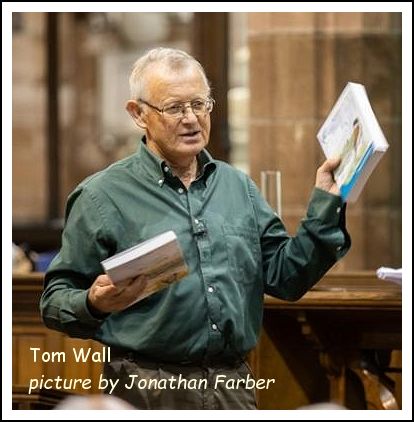 70 Greylags that arrived from the north in two groups; a fine sight as they rapidly lost height by "whiffling" before settling noisily onto the water of number 3 bed. 70 Greylags that arrived from the north in two groups; a fine sight as they rapidly lost height by "whiffling" before settling noisily onto the water of number 3 bed.A good day for raptors too with four species recorded, star of the show was a late Hobby seen twice hunting over the reedbeds - this could well be the last we'll see this year as it's getting quite late for hirundines and dragonflies, although when we were making our way back to the cars a Southern Hawker perched nicely soaking up the heat on what was a cool but sunny day, nearby butterflies fed on the buddleias - Comma, Painted Lady, Speckled Wood, Small Tortoiseshell and Red Admiral. There was an impressive gathering of about 80 people at Rostherne Church last Saturday (28th) for the long-awaited launch of Tom Wall's two books on Rostherne Mere. It's been well worth the wait for these publications! The first volume (383 pages) is entitled "Rostherne Mere, aspects of a wetland nature reserve - wildlife, people and science through time". The second (249 pages) "Rostherne Mere - Birds of mere and margin - one hundred and thirty years of observations". "Aspects" is edited by Tom and his wife Giséle and as the subtitle suggests - wildlife, people and science through time - is a very comprehensive introduction to the Reserve. The book is thankfully printed in larger, easy to read type and progresses in an easy to read manner from the days of Coward and Boyd, when the area was owned by the Egertons at Tatton Hall, through to the present day via sections devoted to it's designation as a Reserve and some pretty esoteric scientific subjects authored by specialists in their particular field. Plenty of impressive "new" words to get to grips with - limnologists, eutrophication, phytoplankton, guanotrophy, anthropogenic et al. but For "Birds of mere and margin" Tom is joined by two Rostherne stalwarts: Steve Barber and Bill Bellamy. They follow Coward's approach and the book covers all aquatic species and those that make significant use of the water body, it's margins and vegetation. They draw upon historic data from Coward's Faunal Survey of Rostherne Mere (1914), Boyd's account from 1955 with the same title and Ron Harrison and David Rogers's "Birds of Rostherne Mere" (1977). Data from the early years are limited due to restricted access to the mere, fewer competent observers and perhaps Coward's reluctance to carry out accurate counts - he seemed to be happy with "many", "few", "substantial" etc! Also we should bear in mind that the incredible optical equipment we take for granted nowadays wasn't available. Things improved from 1961 when Rostherne was declared a National Nature Reserve and the following year with the opening of the A.W.Boyd Memorial Observatory where permit holders were able to use a superb Zeiss (133X) telescope donated by the Budenberg family. In January 1963 a log book was provided and later a daily "tick" list, additional data are generated by the monthly wildfowl counts, CBC type surveys and ringing results. Two excellent volumes that are essential reading for all Cheshire birdwatchers!
We've continued to enjoy excellent views of the Rostherne Hobbies over the past week with one or sometimes two birds showing every day during the recent spell of pleasant late summer weather, they sometimes 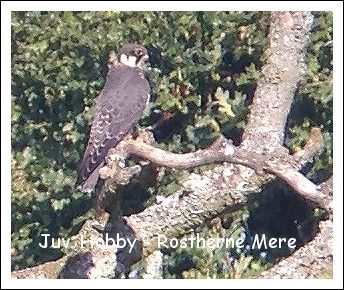 perched quite close to the obs. and I even managed to get a half-decent record shot of a juvenile using my 'scope and phone camera! But of course all good things must come to an end and, along with the autumn equinox on Monday (23rd), things have deteriorated somewhat and although it's still quite mild, low pressure systems have been arriving from the west bringing spells of heavy rain, so perhaps these delightful little summer visitors will consider it time to head south for the winter before too long. perched quite close to the obs. and I even managed to get a half-decent record shot of a juvenile using my 'scope and phone camera! But of course all good things must come to an end and, along with the autumn equinox on Monday (23rd), things have deteriorated somewhat and although it's still quite mild, low pressure systems have been arriving from the west bringing spells of heavy rain, so perhaps these delightful little summer visitors will consider it time to head south for the winter before too long.Bob Groom has spent some time on the reserve and, as well as the Hobbies, had a female Marsh Harrier on Sunday (22nd) and the previous day whilst doing the monthly wildfowl count at Tabley two more Hobbies ( A lot more activity than last month in terms of ducks, geese etc. An exceptional number of gulls and at least 250 Lapwings! Only 2 cygnets left with the adults. At one point there were two Hobbies circling high over the mere plus several Buzzards and a probable Peregrine, which shot through like a thunderbolt. No hirundines seen (no swallow roost up the lanes this year, despite lots of maize fields) but an awful lot of Starlings.). Ken and Shirley Davies have returned safely home from their Summer in Scandinavia and as usual Ken has kindly provided a substantial list of the species they encountered - Our trip started on the 22nd of May and we arrived home on the 11th of September. The birding was a little disappointing having started out a later this year travelling from Harwich to the Hook of Holland and on through Holland, Germany, Denmark ferry over to Sweden over to the East coast of Sweden to the Island of Oland then all the way up the East coast of Sweden and over to the Norway and on to the Lofoton Isles and returning South via Sweden ferry to Rostock for a wine festival and home. The weather was good with rain mainly at night (thankfully) a round trip door to door of 5,986 miles......Welcome back team!
This Friday (27th) it's the first of our season of indoor meetings when Paul Hobson will be talking to us about "Coasts and Islands" - Usual time and place! The following day (28th) it's the launch of Tom Wall's two books about the Rostherne Reserve - 2pm at Rostherne Church. Refreshments will be provided. 17/09/2019...... September trip to the Wirral peninsula There was a disappointing turnout on Sunday (15th) for the first of our new season of field trips. We had intended to go over to Hilbre Island but after due consideration of the demographics we decided shortly before the day to go to Red Rocks for the high tide, so avoiding the long and quite arduous trek out to the island. So we had a later start than would have been needed for plan "A" and went first to our favourite "standby" the RSPB's excellent Burton Mere Wetlands reserve. There was a noticeable passage of hirundines - Swallows 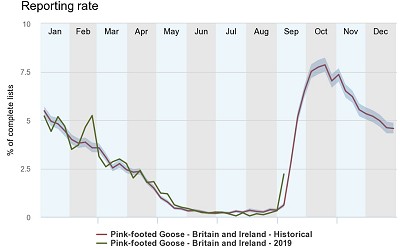 and House Martins were passing through in good numbers during the couple of hours we spent there. Black-tailed Godwits and a single Green Sandpiper fed just in front of us on the muddy borders of the reception pool; further out on the main scrape more Godwits, Lapwings, Snipe, a dozen Ruff, 23 Dunlin and, right on the far side, a Little Stint - difficult to locate with binoculars but showing reasonably well through the 'scopes. and House Martins were passing through in good numbers during the couple of hours we spent there. Black-tailed Godwits and a single Green Sandpiper fed just in front of us on the muddy borders of the reception pool; further out on the main scrape more Godwits, Lapwings, Snipe, a dozen Ruff, 23 Dunlin and, right on the far side, a Little Stint - difficult to locate with binoculars but showing reasonably well through the 'scopes.We walked from the Reception building as far as the wooden boardwalk leading to the IMF hide, passing a calling Chiffchaff and two singing Cetti's Warblers on the way. As we turned to re-trace our steps came one of nature's most evocative sounds - Pinkfeet! 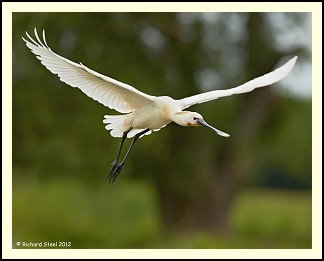 Two flocks appeared over the trees flying in from the estuary, a total of around 110 birds, the highest number on the reserve so far this season; the BTO report that this year the species is arriving back here in the UK slightly earlier than normal (left). Two flocks appeared over the trees flying in from the estuary, a total of around 110 birds, the highest number on the reserve so far this season; the BTO report that this year the species is arriving back here in the UK slightly earlier than normal (left).We arrived at Red Rocks about an hour before high tide but the sea wasn't playing ball and huge areas of sand were left exposed up towards West Kirby, so it was here that the majority of waders had congregated, but a few flew past us and we were able to add Curlew, Oystercatcher and Ringed Plover to what was becoming quite a good day list. We could see other birders on Hilbre and you can see what they recorded on the island's blog [click here]From Red Rocks we drove back the short distance to Parkgate, parked at the far end of the promenade and walked back as far as the Parkgate Fish and Chip Shop, I can report that the food is as good as ever. As an added bonus, as we sat in the dining room, the ever alert Roger Barnes pointed out two Great White Egrets flying out over the estuary - perfectly framed in the window of the chippie! Before leaving for home we continued for a short distance along the promenade to a spot giving better views of the two large pools a couple of hundred meters out on the marsh. Redshanks were very active here and we caught glimpses of a number of white heads moving methodically from side to side - Spoonbills busy feeding. After a few minutes they took to the air; there were seven of them and they made a magnificent sight, pure white birds against a backdrop of light grey clouds and the darker outline of the Welsh coast. Species #60 for the list and a great way to end our day on the Wirral.
We don't see many Swifts in September, most of them have moved south by now, so Bob Groom's bird over Tabley Road on Friday (6th) was a good record and perhaps the last we'll see of them until April next year. We met up with Bob at Rostherne Mere on Thursday (5th) when I arrived in the company of Graeme Allen, a Scottish birder who'd travelled down to our part of the world for the Ashes Test Match at Old Trafford and, having a spare day in his itinerary, contacted me with a request to visit a few of the sites that so far he'd only read about on this website. It was a timely arrival too as Bob had been watching a Hobby hunting insects out towards the centre of the Mere before returning to it's favourite perch on the edge of Harper's Bank wood. After some time it was joined by a second bird, both unperturbed by the attentions of three local Jays that didn't seem too pleased with the arrival of the two intruders. Distant views unfortunately as the birds had been using perches much nearer the obs. the previous day but another excellent record for the reserve. So a good introduction to Cheshire birding for Graeme although I think he was equally impressed by close views of the Nuthatches on the obs. bird table - abundant here but only a very rare vagrant in Aberdeen! From Rostherne we moved over to Tatton Park and the aptly named Allen hide! I'd had brief views of a Hobby last week but on Thursday we were delighted to have great views of an adult bird perched on the two dead trees on the edge of Melchett Mere from where it made frequent forays over the reeds in search of dragonflies. Eventually the weather clouded over and an increase in wind speed must have grounded the flying insects and the Hobby left in the direction of Mobberley, our cue to do the same and time to introduce Graeme to the delights of Goostrey's sausage rolls! It's a good year for Hobbies with regular sightings at Woolston, Burton Mere and Frodsham. Jacquie Ledward has enjoyed good views of the species at home in Comberbatch........ Your latest news promoted me to let you know that just recently I've had regular sightings of the hobby over Comberbach. They've flown over my house too. I've heard them calling in the distance in what seems like the Comberbach/Antrobus area. Sue and I have walked all around the Comberbach/Antrobus area last weekend afternoon but we did not have any sightings of them. However on Tuesday I spotted four hobbies flying and doing food passes in the vicinity of Senna Lane (all from my garden) and when I've seen them they always seem to fly in that direction. They have appeared on a daily basis for the past week, including a lovely sighting of one over my house this evening.....Thanks Jacquie. Still on the subject of raptors the Dyfi Ospreys have left after another successful season, the cameras switched off and work is beginning on the new Dyfi Wildlife Centre - it seems a long time ago since we were there in May on our 45th anniversary trip! 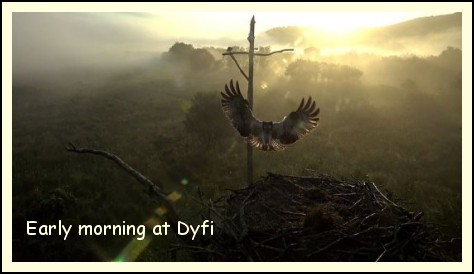 The Dyfi Ospreys arrived in the area naturally, but there are translocation schemes ongoing where young birds from a sustainable population are transferred to other areas. The Rutland scheme is well-documented but I hadn't heard about the Poole initiative until I recently received an interesting email from Wendy Stratford, another Mobberley resident, and long-time reader of our website....
Last week I went on an "Osprey" boat cruise in Poole Harbour - run by the Birds of Poole Harbour charity and hosted by the founders Paul Morton and Mark Constantine. Thought you might be interested as you reported seeing an osprey heading south recently.
We saw 4 different ospreys - 2 birds that were en route South, 1 bird that has been raised near the harbour as part of the Osprey Translocation project, and a female that has been socialising with the local birds for the last 2 years.. The charity seems very positive that ospreys will breed there next year (year 4 of the project). The tech the charity and their partners use is impressive. They have watchers in the harbour who identify the birds by their rings (they recognise the local birds as well) as part of their ongoing monitoring, but they also pass the information to the boat when there is a cruise in progress - so we knew exactly what we were watching. The harbour is so attractive to the ospreys because it is shallow and teeming with grey mullet apparently! We also saw marsh harrier, hobby, spoonbills and many waders etc. The harbour is currently visited by many cormorants from the Netherlands, which fish in huge groups (we saw more that 40 together!) as opposed to singly or in pairs.
Good to meet you a couple of weeks ago! The Dyfi Ospreys arrived in the area naturally, but there are translocation schemes ongoing where young birds from a sustainable population are transferred to other areas. The Rutland scheme is well-documented but I hadn't heard about the Poole initiative until I recently received an interesting email from Wendy Stratford, another Mobberley resident, and long-time reader of our website....
Last week I went on an "Osprey" boat cruise in Poole Harbour - run by the Birds of Poole Harbour charity and hosted by the founders Paul Morton and Mark Constantine. Thought you might be interested as you reported seeing an osprey heading south recently.
We saw 4 different ospreys - 2 birds that were en route South, 1 bird that has been raised near the harbour as part of the Osprey Translocation project, and a female that has been socialising with the local birds for the last 2 years.. The charity seems very positive that ospreys will breed there next year (year 4 of the project). The tech the charity and their partners use is impressive. They have watchers in the harbour who identify the birds by their rings (they recognise the local birds as well) as part of their ongoing monitoring, but they also pass the information to the boat when there is a cruise in progress - so we knew exactly what we were watching. The harbour is so attractive to the ospreys because it is shallow and teeming with grey mullet apparently! We also saw marsh harrier, hobby, spoonbills and many waders etc. The harbour is currently visited by many cormorants from the Netherlands, which fish in huge groups (we saw more that 40 together!) as opposed to singly or in pairs.
Good to meet you a couple of weeks ago!
Thanks Wendy. Next Sunday (15th September) it's the first of our new season of field trips. We'll be going to Hilbre Island - walking over the sands of Dee from West Kirby. 31/08/2019...... More Hobbies and a trip to Burton Mere Young Hobbies are now on the wing and this perhaps explains the recent spate of records from our area. I had another sighting in Mobberley yesterday (30/8), the third in a couple of weeks, as usual it was the local House Martins that alerted me to the presence of their nemesis. The martins can normally out-manoeuvre 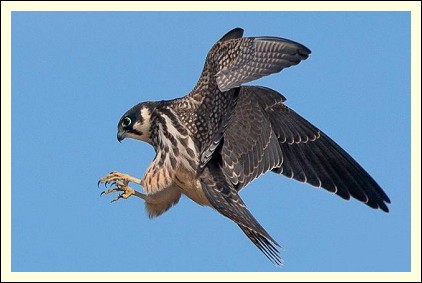 most raptors but the appearance of a Hobby causes great consternation and they use a distinctive warbling alarm call as they circle in a tight group as high as possible above the intruder. In Tatton Park Bob Groom also had a Hobby on the 30th. (and today - 31st) Around 12.20 a Hobby appeared and flew on to the bigger dead tree on the other side of Melchett Mere to eat prey, before flying off towards the gardens. A little later it was back on the tree and then whizzed round over the water chasing insects before landing on the smaller dead tree. A repeat of late August/early September, 2017..Good records and there's still plenty of time for more as they should be with us until the beginning of October. most raptors but the appearance of a Hobby causes great consternation and they use a distinctive warbling alarm call as they circle in a tight group as high as possible above the intruder. In Tatton Park Bob Groom also had a Hobby on the 30th. (and today - 31st) Around 12.20 a Hobby appeared and flew on to the bigger dead tree on the other side of Melchett Mere to eat prey, before flying off towards the gardens. A little later it was back on the tree and then whizzed round over the water chasing insects before landing on the smaller dead tree. A repeat of late August/early September, 2017..Good records and there's still plenty of time for more as they should be with us until the beginning of October.A good start to our trip over to the RSPB's Burton Mere Wetlands reserve on Wednesday (28/8), we recorded a Peregrine Falcon and four Ravens before leaving the car park! As usual there was plenty of activity in front of the reception building - numerous Canada Geese and even more Greylags had been joined by five Barnacle Geese. A Green Sandpiper showed well on the reception pool in front of us whilst further out on the main scrape a few Black-tailed Godwits plus good numbers of well camouflaged Snipe - difficult to pick out until they took to the air from time to time. We knew the weather wasn't going to be too good so we weren't surprised when it closed in and the Welsh coast vanished in the murk and rain! Taking advantage of a break in the downpour we made our way to the Inner Marsh hide where we found more Snipe, a single Dunlin, two Ruff and just one Little Egret - after a successful breeding season the remainder have moved on to pastures new. A tangle of undergrowth containing berry-laden Elder bushes proved attractive to a number of small birds and we had Common Whitethroat, Blackcap, Goldcrest, Willow Warbler and Chiffchaff feeding as we made our way back. A Cetti's Warbler burst into song as we passed along the boardwalk and back to the reception building where Bob and Len reported Marsh harrier, Long-tailed Tit and a Nuthatch bringing the mornings total to a very respectable 54 species. Tom Wall's book launch at Rostherne Church on Saturday 28th September will begin at 2pm. Introduction by Rupert Randall, Reserve Manager.
Derek Pike, Bob Groom and I headed over to Rostherne yesterday morning (19th.) for a couple of hours relaxed birding at this little oasis of peace and tranquillity. Not too much to write home about to begin with, a few Swallows passed quickly 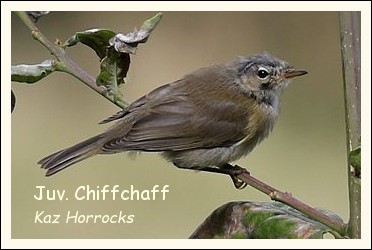 through and a family party of Blackcaps fed in the bushes just in front of the obs. After some time they were joined by a small bird that caused the three of us a problem when it came to it's identity. It was smaller than the Blackcaps, an overall brown plumage but with a greyish head and yellow tinge to the lesser wing coverts. It was very active, it's tail was constantly flicking as it fed on insects, occasionally darting out to take prey on the wing. Basically we hadn't a clue and were bemoaning the fact that none of our KOS photographers was with us, but help was at hand when Kaz Horrocks appeared, complete with some very impressive camera gear! It wasn't an easy task with such a small, quickly moving target but she was able to grab some pretty decent record shots (left). She forwarded them to me later in the evening and I sent them on to a few people I thought may be able to help. A prompt reply was received from County Recorder Hugh Pulsford who had no problem in identifying as a Chiffchaff (This is a recently fledged Chiffchaff. It is in post juvenile moult hence the rather strange head feathering and somewhat fluffy underparts ). Thanks Hugh and thanks Kaz, without the images the bird would have remained unidentified! through and a family party of Blackcaps fed in the bushes just in front of the obs. After some time they were joined by a small bird that caused the three of us a problem when it came to it's identity. It was smaller than the Blackcaps, an overall brown plumage but with a greyish head and yellow tinge to the lesser wing coverts. It was very active, it's tail was constantly flicking as it fed on insects, occasionally darting out to take prey on the wing. Basically we hadn't a clue and were bemoaning the fact that none of our KOS photographers was with us, but help was at hand when Kaz Horrocks appeared, complete with some very impressive camera gear! It wasn't an easy task with such a small, quickly moving target but she was able to grab some pretty decent record shots (left). She forwarded them to me later in the evening and I sent them on to a few people I thought may be able to help. A prompt reply was received from County Recorder Hugh Pulsford who had no problem in identifying as a Chiffchaff (This is a recently fledged Chiffchaff. It is in post juvenile moult hence the rather strange head feathering and somewhat fluffy underparts ). Thanks Hugh and thanks Kaz, without the images the bird would have remained unidentified!I had an easier task this afternoon as I spent an hour on the decking at the back of the house. It's a reasonable place for sky-watching with open views from north through to south so we're able enjoy a little visible migration at the appropriate time of the year. I was actually watching an aircraft passing over when a bird caught my eye moving south. It was quite high up but the light was perfect and I was able to make out the brown and white plumage of an Osprey! Persistence paid off - the right bird at the right time of year. 09/08/2019...... Swifts on the Move Out on the west coast Barrie Armitt has begun his autumn visible migration observations again at Crosby, Merseyside [click here], not much yet but apart from the species that meet the appropriate criteria there seems to plenty of other stuff about to keep The Lad busy! A location on the coast 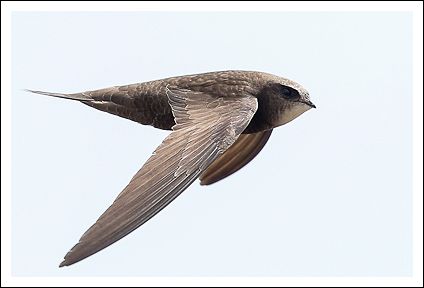 is always going to be best for vis. mig. but from time to time you can see it taking place inland. On Tuesday I was delighted to see a flock of 24 Swifts passing over as I sat in the back garden; none of the screaming or aerobatics you normally associate with the species during the breeding season, these birds were silent and had passed in a few moments as they powered through in a south-easterly direction. Perhaps they'd just had enough of this crazy summer of ours. is always going to be best for vis. mig. but from time to time you can see it taking place inland. On Tuesday I was delighted to see a flock of 24 Swifts passing over as I sat in the back garden; none of the screaming or aerobatics you normally associate with the species during the breeding season, these birds were silent and had passed in a few moments as they powered through in a south-easterly direction. Perhaps they'd just had enough of this crazy summer of ours.We saw a few Swifts on Wednesday on a visit to Woolston Eyes, it was predictably quiet but we managed a reasonable total of 39 species during the morning. The breeding Black-necked Grebes seemed to have dispersed (Rostherne had two recently) and with them their Black-headed Gull "guardians" - it's thought that the nesting gulls help to protect the Grebes by mobbing any predators that appear on the reserve. The wildfowl were mostly still in eclipse plumage but I think we sorted them all out in the end! Garganey have nested at Woolston and a juvenile has been seen on a number of occasions on Number 3 bed. Perhaps a bit beyond our ID skills! There was much activity on and close to the feeders on the left hand side of the Morgan hide - Greenfinch and Blue Tits on the feeders were joined briefly by two Willow Tits whilst in the elder bush just behind the feeders Blackcaps, Chiffchaff and Common Whitethroat.
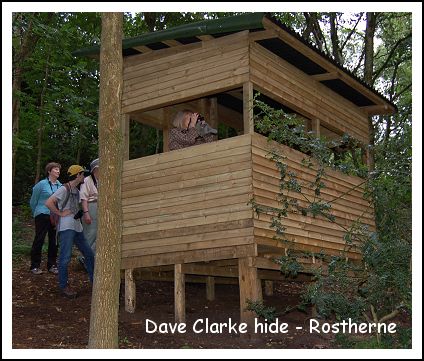 - this time around Rostherne Mere National Nature Reserve. - this time around Rostherne Mere National Nature Reserve.Our guides for the evening were volunteer wardens Phil Dell and Dr. Bill Bellamy who took us first to the main A.W. Boyd Observatory where we spent some time scanning the mere and surrounding woodlands from this high vantage point. Kestrels have nested successfully this year in an old alder tree down near the boathouse and the parents and their three young were showing well for us. Cormorants were still present in good numbers; no less than 176 pairs nested this Spring in Harper's Bank wood on the shores of the mere. More chicks per nest survive at this inland site than equivalent sites on the coast, probably due to less predation by Gulls. Leaving the obs. we made our way down the steep path and into the belt of trees leading to the boathouse and the newly completed hide that will be opened at September's book launch (see below), it will be dedicated to the memory of long standing Rostherne volunteer Dave Clarke who sadly died earlier this year. As you can see from the photo it's a substantial affair and was constructed entirely by Dave's volunteer colleagues. Our party then split into two, Phil took some members over to the Bittern Hide whilst the rest of us followed Bill on a walk around the perimeter of the mere starting in Harper's Bank, through two rutted fields (one of which hadn't been grazed this year, knee high grass which made it hard going [for some]!) and, eventually, into the shade of Mere Covert, the long wood that stretches along the north side of the mere. The light was beginning to fade as we reached the comfort of the Bittern Hide (padded benches!!), a substantial murmuration of c. 300 Starlings built up and eventually the birds dived into the safety of the phragmites reedbed. They were followed shortly afterwards by c.50 Swallows that were also going to roost in the reeds. A few spots of rain appeared as we made our way up through Wood Bongs and back to the cars; the short heat wave was coming to an end and on Sunday (28th) parts of Manchester had over 100mm of rain. My rain gauge showed 51mm (about 2") but it's not calibrated so I take any rainfall readings with a pinch of salt! Our thanks go to Phil and Bill for guiding us around the reserve and for their hard work as part of the volunteer warden team. Rostherne used to have a full-time warden, Tom Wall held the post in the 1970's and 80's and has been working on a book about the reserve for a long time. Apparently it grew and grew and as a consequence, and with the help of other contributors, has now been published as two separate volumes. The two books will be launched at a ceremony on the 28th September at Rostherne Church beginning at 2:00pm. I'm told there will be light refreshments and visits to the Observatory and the new hide - anyone will be welcome whether a member or not. Published 28 September 2019, £ 20 ( £ 23.50 inc p&p) Rostherne Mere Aspects of a wetland nature reserve Wildlife, people and science through time Edited by Tom & Gisele Wall 385 pages, paperback, colour throughout, numerous illustrations, photos and figures, chapters contributed by twelve leading experts. Published 28 September 2019, £ 25 ( £ 28.50 inc p&p)
 23/07/2019......Mobberley hits the headlines! 23/07/2019......Mobberley hits the headlines!If you're lucky enough to see a Cuckoo at this time of the year it will be a juvenile bird, satellite tracking by the BTO shows us that by now all the adult birds will be on their way back to Africa. Swifts will be following them soon, they normally leave us in August and it's unusual to see them any later. They were late arriving this year so I don't know what sort of a breeding season they've had but they're starting to move already, Bob Groom had a flock of 65 over Tabley hill on Saturday (20th). The following day, at the same location, Bob had a post-breeding flock of 200 Lapwings which is most encouraging, that's a sizable gathering for a species under such serious threat. In Tatton on Monday (22nd) Darren Morris had three Common Sandpipers on the concrete boat jetty that juts out into the main mere, we see them there every Spring but they're less common later in the season. What could be the same wandering Red Kite that I saw recently in Mobberley appeared again yesterday (22nd) when Jayne Davies spotted a bird high over Pavement Lane. Also in the village, 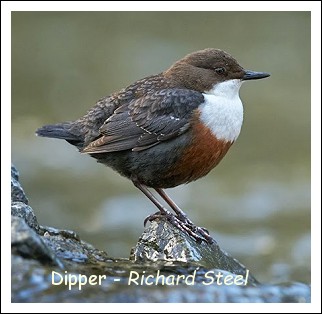 I had quite a shock on Wednesday (17th) as I walked down Slade Lane alongside Mobberley Brook, a route I've taken hundreds of times before, glancing at the stream I was amazed to see a Dipper! It saw me, as I saw it and away it went - all over in a split second, I didn't have time to even reach for my binoculars before it vanished. I had quite a shock on Wednesday (17th) as I walked down Slade Lane alongside Mobberley Brook, a route I've taken hundreds of times before, glancing at the stream I was amazed to see a Dipper! It saw me, as I saw it and away it went - all over in a split second, I didn't have time to even reach for my binoculars before it vanished. The latest Cheshire Atlas does mention records from the lowlands but as far as I know it is a first for Mobberley, County Recorder Hugh Pulsford kindly sent me some more up-to-date information regarding the species in the county - Having done a lot of work on the Dipper population in the eastern hills above Macc for the last 10 years we have found that a few adults do move about post breeding, I have had birds go to Sheffield, several sites in Derbyshire, perhaps predictably along the River Dane, and one flew into a window (being chased by a Sparrowhawk) in Bramhall! Understandably the owner couldn't ID the bird as it's not on the RSPB garden bird poster (but the BTO ring and colour ring combination told us all we needed). Far more likely are roving Juveniles which get pushed out of Mum & Dads patch and follow river and stream systems to new locations. I once had one in August at Alderley Park by Radnor Mere, so they will fly across land if they have to. A nice sighting. Mobberley again made the headlines last week - this time featuring on the TV news when a tornado swept through the village!! It was very localised as my wind recorder in the back garden didn't show it, but only a mile away along Broad Oak Lane huge branches were torn from mature oak trees, a marquee was left draped over a tree in Smith Lane and the roof of the Railway Inn was badly damaged. By a strange co-incidence Tony Davies, landlord of the said hostelry, was sat in an aeroplane that was waiting for the storm to pass before it was safe to take off! - As we sat on the plane at Manchester airport waiting to take off the pilot announced that there would be a slight delay as a weather front was passing through. After a few minutes off we went, flying out over my pub the Railway Inn where beneath us just a few minutes previously the building had been devastated by a freak tornado and half of the roof slates torn off!! Hopefully the weather will have calmed down somewhat by Friday evening (26th) when we have our final evening walk of the year. We'll be paying a visit to Rostherne Mere NNR, meeting up at the Natural England car park at 6:30pm. This is an opportunity for those that have never visited the reserve to see the facilities on offer at the observatory, to have a look at the other two hides (including the new one dedicated to the memory of long time volunteer warden Dave Clarke) and, for those with enough energy, walk right around the perimeter of the mere - about 90') 14/07/2019...... Burton Wetlands and a good record from Tatton
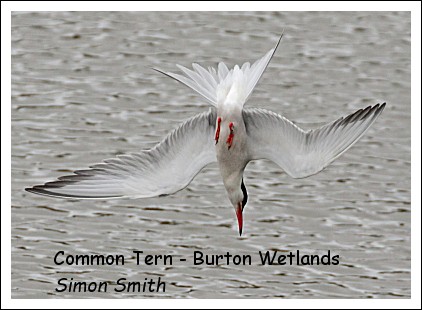 including close up views of a Common Tern as it patrolled the channel closest to the reception centre giving the photographers present a great photo opportunity. Simon took full advantage, as you can see. Thanks Simon that's a great image! Dozens of Black-headed Gull youngsters were packed onto the main island, amongst them, but indistinguishable, except for the fact they were being tended by their parents, Mediterranean Gull chicks. One of the wardens told me that they'd had 10 pairs this Spring, yet another indication, if it were needed, that our climate is changing - we ignore Nature's messages at our peril. including close up views of a Common Tern as it patrolled the channel closest to the reception centre giving the photographers present a great photo opportunity. Simon took full advantage, as you can see. Thanks Simon that's a great image! Dozens of Black-headed Gull youngsters were packed onto the main island, amongst them, but indistinguishable, except for the fact they were being tended by their parents, Mediterranean Gull chicks. One of the wardens told me that they'd had 10 pairs this Spring, yet another indication, if it were needed, that our climate is changing - we ignore Nature's messages at our peril. Other species have also done well this year at Burton - Avocet - 58 pairs, Redshank - 38 pairs and Lapwing - no less than 114 pairs. All very encouraging but really we need Lapwings back in the rest of the countryside and not just restricted to the small pockets provided by protected reserves like Burton. Leaving the reception building we made our way to the Marsh Covert hide, single Cetti's Warbler and a Reed Warbler were still in song and from the hide we had good views of Reed Warblers feeding their now fledged young a few feet away in the phragmites reed bed. A female Marsh Harrier passed over causing a flurry of activity amongst the flocks of Black-tailed Godwits present in large numbers on the reserve. 12 months ago, after a visit to Burton, I took to BWP to try and understand more about the various plumages displayed by these Godwits at this time of the year - suffice it to say it's all very complicated and I'm still none the wiser. Just two species in song as we walked along the boardwalk to the Inner Marsh hide, Chiffchaff and a five second burst of reeling from a Grasshopper Warbler. More Godwits from this hide plus six Dunlin, still in Summer plumage and three Spotted Redshanks, now moulting but readily distinguished from their Common (Redshank) cousins. As we returned to the centre a Peregrine flew through at tree top hight - absolute chaos as everything took to the air, species number 48 which increased by six when Bob Groom sent me a note with a list containing extras seen by him and David Cogger when they visited Parkgate on their way home. Alan Booth kindly sent me details of four Common Scoters (3M,1F) he saw this morning (14th) at the north end of Tatton Mere. Bob Groom saw them later in the day and thought they could have been the four he had at Tabley recently.
July is probably the quietest month of the year for the average birdwatcher, Bill Mulligan, our first president (in 1974), recognised this fact and it was in July each year he took Mrs. Mulligan on holiday! Despite this lull in proceedings as the year reaches a tipping point gardens are busy with successful family parties, here in Mobberley House Sparrow, Goldfinch, Starlings, Blue and Great Tits seem to have done well this year. There's little in the way of song now, the usual 5K walk around the lanes of Mobberley produced only single Goldcrests, Chiffchaff, Reed Bunting, Coal Tit and the usual Yellowhammer along Hobcroft Lane. Hobbies were confirmed as breeding in Cheshire in 1998 when Pete Hall found a nest on his farm in Toft, the first for exactly 100 years since Coward and Oldham's 1898 nest record. Since then there has been an increase in numbers with the latest Cheshire atlas (2004 -2006) showing 37 tetrads with confirmed A species even rarer that the Hobby (in Cheshire) is the Red Kite, so a bird high over Mobberley yesterday (8/7) was a good record. Eventually they'll no doubt become as plentiful as Buzzards, as has been the case in the south of England, where they're apparently in constant view for travellers on the M40 motorway (although I'm not suggesting that there's any need for anyone from around here to ever venture south of Stoke. Such extreme behaviour is rarely necessary!) NB) Olwen and I are currently trying to establish a wildlife pond in the grounds. Having received quotes for the job I ignored everyone's advice and dug it out myself - 6'X4'X2' deep with shallower shelves around the perimeter - it's a whole new world! We've been visiting the "World of Water" emporium in Timperley exploring the intricacies of liners, deep water, marginal and oxygenating plants and even solar powered air pumps! OK it looks a bit rough at the moment but given time I'm sure it will mature and we'll be providing dragonflies for those elusive Hobbies to feed on! This Saturday, 13th July it's our field trip over to Burton Mere where there's something of interest no matter what the time of year! Leaving Lilac Avenue at 09:00 to arrive at the reserve at approximately 10:00am. 30/06/2019...... Mobberley's Yellow Wagtails successful despite the weather Summer seems to have arrived at last with a blast of hot air funneling up from Africa covering most of Europe. Too hot for some though and a temperature of 45.6C over the weekend was the highest ever recorded in France - in any month of the year. More manageable for us in the UK but it was still a very warm 26C on Friday evening at 6:45pm for the second of our Summer evening walks, this time around the Fox Harbour area of Mobberley. Despite the absence of some regulars there was an excellent turnout and 20 members set off from Mill Lane for the 5Km journey through the village bad lands! 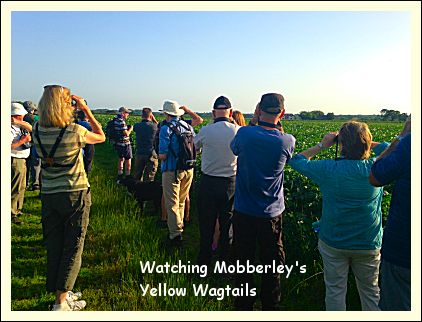 I had given assurances that, after my earlier visits, we were certain to see Yellow Wagtails - I wasn't disappointed and neither were the troops as, within a few minutes of heading into the fields, the birds appeared. It was difficult to estimate how many were present but there were probably six or seven, perhaps more. Certainly there was a family party with two juveniles and the parent birds plus further birds as we moved on. Again they'd nested in the huge potato field next to Gleavehouse farm and would have enough time to raise two broods before the healthy looking crop was harvested - the Yellow Wagtail used to go under the name of the "potato setter" - not without good reason. I had given assurances that, after my earlier visits, we were certain to see Yellow Wagtails - I wasn't disappointed and neither were the troops as, within a few minutes of heading into the fields, the birds appeared. It was difficult to estimate how many were present but there were probably six or seven, perhaps more. Certainly there was a family party with two juveniles and the parent birds plus further birds as we moved on. Again they'd nested in the huge potato field next to Gleavehouse farm and would have enough time to raise two broods before the healthy looking crop was harvested - the Yellow Wagtail used to go under the name of the "potato setter" - not without good reason.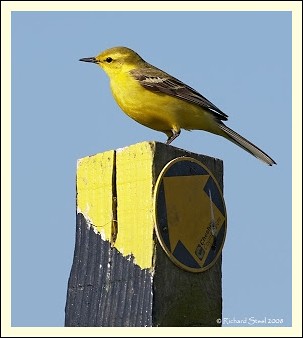 Looking to the left of the track we could see good numbers of Tree Sparrows in the tall hawthorns across the wheat field, above which Skylarks hovered and from the from the far side the song of Yellowhammers one of which posed nicely on top of the hedge allowing time for good views through the 'scopes. Reaching the bottom of the fields and next to the deserted Sand Martin colony, we turned right and walked parallel with Pedley Brook as far as the bridge that carries the driving lane up towards Ollerton. Little in the way of song, it's getting a bit late now, but we did hear Chiffchaff and Common Whitethroat. The air was heavy with grass pollen as the farmers took full advantage of the dry spell to do some hay raking - Lesser Black-backed and Black-headed Gulls following the machines as they moved quickly through the fields. We split into two groups at the bridge with some preferring the shorter route with no stiles giving a walk of about 2.5K - far enough on such a warm evening, whilst the remainder took the lane as far as the now disused fishing pit before swinging west to Springwood farm. It was here the law of diminishing returns kicked in! We were pleased though to see a solitary Lapwing calling anxiously as it slowly flew over a nearby field - a sign that it had young somewhere below. Springwood Farm was teeming with Swallow this time last year but I don't think there were any this time, nor any sign of previous years Spotted Flycatchers. Disappointing. A Red-legged Partridge along Pavement Lane was the first I've seen along there for sometime, we had a Buzzard soaring overhead but the Barn Owl nest box isn't in use this Summer. A little male Sparrowhawk powered past us as we moved along the path overlooking Mobberley SQ but it wasn't a good night for raptors, especially as I'd had a Hobby hunting over Bucklow Avenue earlier in the day! Just 32 species on my list but the evening was about quality not quantity and the first half mile with the Wagtails, Skylarks and Yellowhammers made it memorable for all the right reasons! One bird missing from Bob Groom's European tick list is Northern Hawk Owl so last month, in an effort to rectify the situation, he spent a week in the far north of Finland in search of this Arctic beauty - as usual he's kindly provided a summary of his trip and you can read it by clicking here thanks Bob!
It certainly does! Yesterday was the Summer solstice; the longest day of the year. Today (22nd) will be 2 seconds shorter, tomorrow 8 seconds and in a weeks time we'll be loosing 49 seconds per day. It'll soon be Christmas! The miserable, wet weather this month won't have helped ground nesting species but shouldn't have affected others quite as Bob Groom had what were probably four Common Scoters whilst doing his wildfowl count at Tabley Mere last Sunday (16th) but wasn't sure of the ID as they were in view for only a few seconds through the undergrowth. I've seen them on Tatton Mere in June on a number of occasions over the years - it seems strange but this seems to be this month that provides most inland records. Bob was disappointed to have no sightings along the Tabley bridleway of Yellow Wagtails - ground nesters so they may have succumbed to the recent bad weather. Hopefully our Mobberley Wagtails have done better and we'll enjoy their company again this coming Friday (28th) during the second of our KOS evening walks around the village, meeting up in Mill Lane Mobberley (the road down to the Bulls Head and Roebuck pubs) at 6:45pm. WA16 7HX. Leader Tony Usher.
The scheduled KOS field trip to the Manifold Valley yesterday (8/6) was abandoned; the weather was just too bad for such a location, high up in the Pennines with so little cover. The forecast gave a 100% chance of rain at 10:00am so, after some late evening and early morning phone calls, texts and emails, it was decided to again head over to the RSPB's Burton Mere Wetlands reserve where there would at least be the hides and some shelter from the elements. An important point here. details of all our trips and their individual trip leaders are available on this website and also in the printed programme handed out when annual subscriptions are paid. It would be helpful if members would let the leaders know in advance if they intend to attend, especially if they will be going straight to a venue, rather than meeting up beforehand in Knutsford, either Tatton Street or Lilac Avenue. With such a relatively early start we arrived before opening time at the reserve, but it wasn't long before the staff arrived and got the coffee on - very welcome! From the reception building Reed and Sedge Warblers sang from the reeds as we progressed along the boardwalk towards the Inner Marsh hide, along the way three or four singing Cetti's Warblers and good numbers of Common Whitethroats, leaping into the air in song flight. From this far hide we added Greenshank to the day list; Swallows, Sand and House Martins with a few Swifts sped past and a flock of 30 or 40 Black-tailed Godwits roosted, safe in the centre of the lake. 57 species recorded, a good total and compensation, if it were needed, for missing out this year on the Manifold Valley. Closer to home Darren Morris tells me he discovered a brood of three Barn Owl chicks when checking one of the Tatton nest boxes and a Mandarin Duck on eggs in a nest hole, also in the Park. Across the road from Tatton, in downtown Mere, Geoff and Sheila Blamire are being visited by both male and female Siskins, they suspect the pair are nesting nearby. This will be an excellent record for the area if confirmed as it's a rare breeding species in Cheshire. Our Hobby correspondent Bob Groom continues to have a magnetic effect on the species and reports that this morning (9/6) he watched a bird hunting for insects over Rostherne Mere. Hopefully it'll stay around, I've yet to see one this year!
02/06/2019...... The Goyt Valley When driving from Macclesfield to the Goyt Valley via Rainow it's always a good idea to stop on the way at Pym Chair, at the top of the hill just after Jenkin's chapel. It's possible here to pick up species like Skylark and Red Grouse before dropping down to the Goyt. We did this on Friday (31/5) before meeting up with the rest of the KOS for the first of our three Summer evening walks. No Grouse but we did have Skylark and Meadow Pipit as well as wonderful views across the Cheshire Plain. The weather was bright and clear and in the distance we could see Liverpool cathedral (40 miles as the crow flies) with the naked eye and, with the aid of binoculars, the wind turbines out in Liverpool Bay. A great turnout of 19 members assembled in the middle car park along the valley before splitting up into two groups; one chose to tackle the steep hill behind the car park and walk along the bumpy path that runs parallel with the road As we returned to the cars and were preparing to leave some jobsworth in a pickup truck appeared and told us that the path we had used was no longer in use and we shouldn't have been in there. Well it still has a pedestrian gate and the map has it marked as a footpath! United Utilities need to lock the gate and put up some appropriate signs - It was fortunate that Mr. Jobsworth was talking to our charming Chairperson and not the Hon.Sec. - he had a lucky escape!! On his return from Finland and a successful search for the Northern Hawk Owl Bob Groom was immediately out and about around the Knutsford area and reports a Red Kite on 31/5 at the Hobby site, a Hobby near St. Paul's church Over Tabley and Yellow Wagtails along the Tabley Hill bridleway. Bob's promised me a report of his Finland trip which I'll publish on this website. The Dyfi Ospreys are progressing nicely and the three chicks are looking very strong - click here I've been watching another Osprey webcam near Loch Arkaig in Scotland, again superb images in full HD - quite amazing as, in their own words, The nearest plug socket? More than a mile away. Broadband? The other side of 2km of water. it's well worth a visit just to read and watch video of how this has been achieved! Click here.This coming Saturday (8th) it's our field trip over to the beautiful Manifold Valley leaving Lilac Avenue at 08:30am to arrive at Ecton around 09:40am. Leaders Derek Pike and Mark Eddowes - so you'll be in safe hands!
I paid a long overdue visit yesterday (28/5) to the little known or visited area of Mobberley to the south of Town Lane known as Fox Harbour (shown as such on 19th. century maps). KOS members will be more familiar with it than most as it's been the venue for one of our Summer evening walks for the past few years. I began at the white cottage at the top of Mill Lane where the gate to the track now bears a new notice informing us that this is "Private Land. No public right of way". 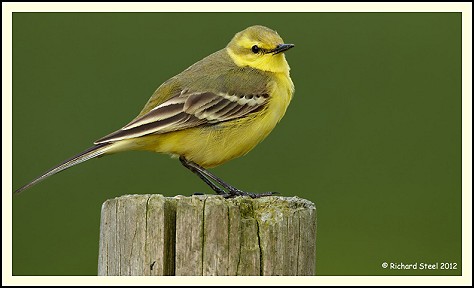 Well I've been using it for more than 70 years so I'm not about to stop now! Well I've been using it for more than 70 years so I'm not about to stop now!The first big ash tree on the left held a noisy family party of Tree Sparrows where we've seen them in previous years, albeit a month later in the season, perhaps these are second or even third clutches. I was hoping to see the now red listed Yellow Wagtails in the potato fields a little further on and I wasn't disappointed. A male and female were feeding on a manure heap in the corner of the first potato field, at the same time a second male was fluttering over the centre of the field, a further pair were perched on the boundary hawthorn hedge and another two birds, one carrying food, hovered over the wheat field on the left. Very encouraging and I hope they're still there when we have our walk in June. The wheat field also seemed popular with the local Skylarks, two were high in the sky singing, with four others interacting lower down over the crop. The Sand Martin bank was unfortunately deserted again but the rest of the swampy area next to Pedley Brook held some good birds with Chiffchaff, Linnet, Common Whitethroat, Chaffinch, Reed Bunting, Dunnock, Wren, Blackcap and Robin all in song. No Willow Warblers though and just a single Yellowhammer singing from the electricity cable alongside the track leading up to Gleavehouse Farm. Reed Buntings and Chaffinches were feeding young at the (ex) fishing pit but no Moorhens this year, also missing, Spotted Flycatchers at Springwood Farm, perhaps the building work taking place was putting them off, although they are few and far between this Spring - I've yet to see one. Along the road leading up to Pavement Lane farm a pair of Yellowhammers where we saw them last Summer and just beyond the farm a Little Owl flew out of a roadside birch tree over towards the oak trees where they're no doubt nesting. 36 species in a walk of 5.2K, not bad but I can't help but reflect on the ones that are no longer with us - Curlew, Lapwing, Corn Bunting and Snipe; will the Yellowhammer be added to this list before too long? Our friends at Dyfi will be pleased, the nest we saw a couple of weeks ago now contains three newly hatched chicks and all seem to be doing well - click on live streaming. This Friday evening (31st) it's the first of our KOS summer evening walks. This one is to the Goyt Valley and beyond. Leaving at 6:30 pm from the Tatton Street car park or 7:30 pm at the second car park along the valley. You may want to bring a torch and a woolly jumper as we probably won't get back to the cars before dark.
The Arctic Tern flock at Rostherne increased from 7 to 30 during the afternoon of 8th May; 9 remained the following day. Darren Morris reports that none were seen at Tatton on the 8th. I checked the park on the 10th and was lucky to see a Common Tern on a buoy in the centre of the main mere, in Dog Wood a Garden Warbler showed well and a male Grey Wagtail was watched collecting food near the concrete jetty. Today (22/5) Darren told me that he'd seen a female Mandarin Duck with 5 chicks on a stream in the deer park. The 45th Anniversary holiday went very well and we achieved our target of 100 species! It's a bigger report than normal so qualifies for a page of it's own! click here for the report 09/05/2019...... Hobbies back on site!It was well into the breeding season last year before Bob Groom was able to confirm that "his" Hobbies had bred again at their site not far away from Knutsford. No problem this time though as he saw the pair last Friday (3/5) from the usual viewpoint - most encouraging - well done Bob! Lesser Whitethroats have also returned to their favourite locations; on Monday (6/5) a male was in full song along Breach House Lane in Mobberley, showing well as it moved through a roadside oak tree above the tangled undergrowth, where it will no doubt build trial nests in the hope of attracting a mate. A brief drive away at the airports crashgate 9 another was heard in the distance 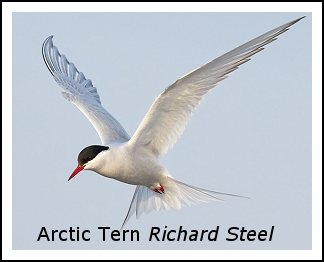 rattling away as I began a short walk along the perimeter paths as far as the last of the dwellings, where the view opens up to reveal the whole of the airport. Summer migrants in the form of Chiffchaffs, Blackcaps and Common Whitethroats were present in good numbers along with three singing Willow Warblers - not many about this spring apparently. We normally hear many Skylarks along this route, the 1000's of acres of grassland that border the two runways are perfect nesting sites, unfortunately the grass has to be kept short for reasons of safety and a large mowing machine was in action doing its stuff. It seemed to be set quite high, leaving a few inches of grass showing but it had four big wheels and the mower six at the rear so this probably takes its toll every year. only one Skylark was heard. rattling away as I began a short walk along the perimeter paths as far as the last of the dwellings, where the view opens up to reveal the whole of the airport. Summer migrants in the form of Chiffchaffs, Blackcaps and Common Whitethroats were present in good numbers along with three singing Willow Warblers - not many about this spring apparently. We normally hear many Skylarks along this route, the 1000's of acres of grassland that border the two runways are perfect nesting sites, unfortunately the grass has to be kept short for reasons of safety and a large mowing machine was in action doing its stuff. It seemed to be set quite high, leaving a few inches of grass showing but it had four big wheels and the mower six at the rear so this probably takes its toll every year. only one Skylark was heard.The cold spell continues, yesterday (8/5) the temperature only reached 10.5C with an easterly wind and periods of drizzle making it feel more like December. I spent a couple of hours in the obs. at Rostherne where small groups of Swallows and House Martins fed low over the mere picking newly hatched insects from the surface. They were joined from time to time by single Swifts - they are late this year with Jude Halman and Derek Pike both reporting zero sightings so far around their favourite spots in Knutsford. My optimism was rewarded at 11:15 am when a flock of seven birds arrived from the south-west - Arctic Terns! I had a reasonable view as they flew in but subsequently they moved to the eastern end of the mere and were only in view fleetingly through the trees but I was pretty certain of their identity. The weather forecast for next week is encouraging with a high pressure system set to bring dry and warm conditions from Monday onwards. Ideal for our KOS 45th anniversary trip to mid-Wales from Wednesday (15th) until Sunday (19th) based in Barmouth. 100 species again? We'll be doing our best! 02/05/2019...... Plenty of good records from Tatton Tatton Ranger Darren Morris has sent me details of some nice birds he'd seen recently in the park. On Tuesday (30th) he had Whinchat and Wheatear in the deer park and on the 25th April two Hobbies were hawking for insects over the main mere, I think these were the first Hobbies recorded in Cheshire this year. Encouraged by Darren's 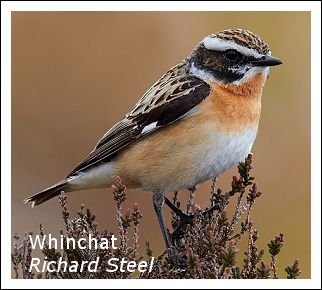 sightings a small group of mid-weekers enjoyed a walk around Tatton yesterday (1/4) hoping, amongst other things, to see the first Swifts of the season - they're late this year and by tradition have always returned in time for Knutsford's annual May Day festivities, this year taking place on Saturday 4th. sightings a small group of mid-weekers enjoyed a walk around Tatton yesterday (1/4) hoping, amongst other things, to see the first Swifts of the season - they're late this year and by tradition have always returned in time for Knutsford's annual May Day festivities, this year taking place on Saturday 4th.We took the usual route - Knutsford Moor, Dog Wood, the Allen hide then back along the west side of Tatton mere. Blackcaps and Chiffchaffs were singing as we made our way down towards the Moor where a newly returned Reed Warbler was in full song from the reed bed. Climbing up from the Moor towards Dog Wood more Blackcaps and a Common Whitethroat although we were disappointed that there was no sign of the Garden Warblers that can often be found here with its mountains of bramble and convenient song posts. Dog Wood was unusually quiet given the time of year as was the main mere, just a few Great Crested Grebes, Mallard and a late female Goldeneye, although we were delighted when a Common Sandpiper flew up from the waters edge and settled on the far bank - a new bird for the year for most of us. A second Common Whitethroat was in song as we approached the Allen hide and a Grey Wagtail called as it passed over, whilst from the hide itself we were surprised to see a pair of Egyptian Geese with three small youngsters in tow. Darren told me some time ago that a pair had hatched five young from a nest near the mansion with another pair seen with offsprings on the Toft estate. No Swifts as we made our way back towards the Knutsford entrance, not a single hirundine either, although as we passed the Moor pool two Swallows flew over, late additions to a modest day list. So it appeared that this year Swifts wouldn't be recorded in our area on or before the first of May but help was at hand in the form of local birder Alan Booth who we encountered as we headed back to the cars. Alan told us he'd had Reed and Sedge Warblers and two Swifts on Sunday 28th April!
The spell of warm weather we were blessed with over the Easter weekend came to an end yesterday afternoon (24th) with an intense thunder storm at around 3:30pm. We'd spent the morning enjoying the final few hours of the nice weather around Neumann's Flash in Northwich, a good turnout of 15 mid-weekers for a gentle stroll around 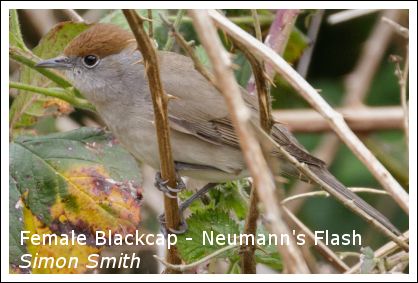 the perimeter before moving on to Haydn's Pool in search of summer migrants - about 2 miles in total. the perimeter before moving on to Haydn's Pool in search of summer migrants - about 2 miles in total.Three warblers in song before we'd left the car park with Chiffchaff, Willow Warbler and Common Whitethroat all doing their stuff, whilst a couple of hundred yards along the embankment two or three distant Sedge Warblers and a Cetti's. Blackcaps seemed to everywhere and we thought we'd heard a Garden Warbler deep in the undergrowth but couldn't be certain, nevertheless the species was added to the day list as Bob Groom had one in song along the different route he'd taken, along the path running in between Neumann's and Ashton's Flash. A pleasant surprise awaited us as we met up at the big hide on the far side of the flash - a Cuckoo calling; I didn't hear one in Cheshire at all last year! Also in that area Green and Great Spotted Woodpeckers whilst on the water in front of the hide, amongst a fair selection of wildfowl, a Whooper Swan that, for one reason or another, had not migrated north to Iceland for the summer. Hirundines were in short supply with only a couple of Swallows passing over, additionally no Swifts so far this spring, there are normally a few around by now, it looks as though the recent spell of bad weather over Spain and Portugal has held them back during their journey up from Africa. Making our way towards Haydn's pool Reed Warblers were singing from the phragmites at the side of Neumann's and we added Nuthatch, Mistle Thrush and Goldcrest to the day list. Very little water at Neumann's unfortunately, the only species of note was a Sparrowhawk circling over the old ICI works in the distance. Tomorrow evening (26th) it's our KOS AGM which normally takes all of 10 minutes! no one will be press-ganged into serving on the committee as all last year's officers have volunteered to continue for another 12 months. Admission is free and after the short formalities Sheila and Geoff will be giving us a presentation entitled "Texas the Roadrunner State".
Another cold day on Sunday (14th) for our April field trip - up the M6 to the RSPB reserve at Leighton Moss. The temperature never reached double figures all day and a strong easterly wind didn't help matters, although once in the shelter of the reed beds it felt pleasantly warm. We began with a climb up the sky tower, as you can imagine it was perishing up there but we were rewarded with excellent views from above of some of the resident Marsh Harriers floating over the reserve, the male birds looking magnificent as the morning sun caught them twisting and turning over the reeds. Having ticked off some of the commoner species also to be seen from the tower we made our way down and set off along the track towards the Tim Jackson hide; Chiffchaffs, Blackcaps and Willow Warblers were all in song as well as the resident Cetti's Warblers exploding into action from the undergrowth, we did actually catch fleeting views of a couple of individuals but they do tend to remain well-hidden almost all the time. Also along the paths were the Marsh Tits - great views as usual of this rapidly declining species. As we approached the Jackson hide we heard our first Reed Warbler of the year - Sedge Warbler had apparently also been heard but we had just this single Reed during our visit. A short drive and walk found us at the coastal hides from where we had some spectacular views of the species present. The islands were covered with a rufous cloak of 100's of Black-tailed Godwits in a confusion of plumages! From time to time, perhaps spooked by a passing predator, the whole lot would take flight and a number of smaller grey birds, about 50, revealed their presence amongst the Godwits. They were Knot, apparently still in winter plumage, perhaps 2nd calendar year birds that won't attain their characteristic Summer plumage until next year. A knowledgeable local birder also pointed out three Bar-tailed Godwits amongst the flock of Black-tailed, we'd have overlooked those without his help!
So far April has been colder than March and days of adverse weather conditions over the past week caused a build up of summer migrants at suitable locations as they paused in their journey north. Bob Groom had what must be a record count of Sand Martins over the Tatton meres last Thursday (4th) .......... I paid a visit at lunchtime and there were Sand Martins literally from one end of Tatton Mere to the other. It was mesmerizing watching them, a rough guesstimate would be 1,500 birds. There were 5 Swallows over the Head-of-the-Mere 'pool', didn't see any 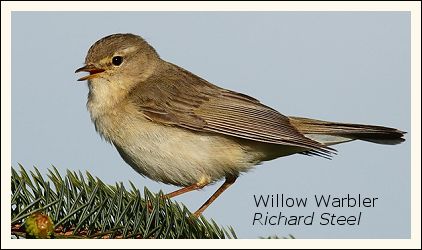 others but then visibility wasn't good. Also 66 Sand Martins over Melchett Mere. I headed home when the wind got stronger and the rain even heavier. Just hope there were enough insects for them all!. Tatton ranger Darren Morris reported 100's of Sand Martins the previous day plus the first House Martin of the year over Melchett Mere; Darren also counted 12 occupied Herons' nests in the park's Higmere Plantation. I had a look on Saturday (6th) and there were well-grown young on view but some birds seemed to be on eggs - perhaps replacement clutches after problems caused by the gales in March. others but then visibility wasn't good. Also 66 Sand Martins over Melchett Mere. I headed home when the wind got stronger and the rain even heavier. Just hope there were enough insects for them all!. Tatton ranger Darren Morris reported 100's of Sand Martins the previous day plus the first House Martin of the year over Melchett Mere; Darren also counted 12 occupied Herons' nests in the park's Higmere Plantation. I had a look on Saturday (6th) and there were well-grown young on view but some birds seemed to be on eggs - perhaps replacement clutches after problems caused by the gales in March.In Dog Wood I had 4 singing Chiffchaffs and 6 Blackcaps but no Willow Warblers, although the previous day (5/4) David Cogger had one fly into his house through an open door; he managed to catch and positively identify it before sending it on it's way! Darren heard one singing in the deer park in Tatton on Monday (8th) but the rest of us had to wait until Wednesday (10th) for our first of the year when two were in song at Woolston Eyes. It was fine and sunny at Woolston but only 8C with a biting easterly wind - scarves and gloves still the order of the day! Other summer visitors included Chiffchaffs, Blackcaps and small parties of hirundines that were passing quickly through - still mostly Sand Martins with a few Swallows and just a single House Martin. All the usual wildfowl were present - Mallard, Shelduck, Tufted Duck, Greylag and Canada Geese, Teal, Coot, Moorhen, Gadwall, Pochard, Mute Swan, Shoveler, Little and Great Crested Grebes plus the reserve's speciality - Black-necked Grebes of course! 17 had been counted earlier, it took us sometime to locate any but eventually a pair were located in the reeds opposite the Morgan hide from where we also noted the nesting pair of Lapwings on one of the small islands just below the hide - the female bird was incubating three eggs. Just a single Brambling remained under the feeders, two further pairs of Black-necked Grebes showed well from the Frank Lindley hide from where a Cetti's Warbler sang briefly as we left. This Sunday (14th) we have our April field trip to Leighton Moss. 08:30 from the Tatton Street car park or c. 10am at the reserve. A great time of the year to visit Leighton and we should have booming Bitterns and plenty of summer migrants, hopefully including the first Reed and Sedge Warblers of the year!
Tatton's not a place for most waders - there are no large areas of mud to attract them, so a Redshank seen from the Allen hide at the side of Melchett Mere by Bob Groom was a nice record for the park. In the past 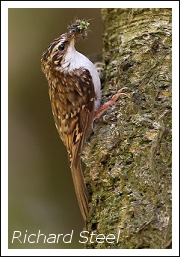 the water level of the main mere was lowered every winter to give access for the removal of bottles etc. near the old bathing area exposing large areas of mud which attracted Dunlin, Ringed Plover, Redshank etc. the water level of the main mere was lowered every winter to give access for the removal of bottles etc. near the old bathing area exposing large areas of mud which attracted Dunlin, Ringed Plover, Redshank etc.The same observer was over at Marbury Park last Thursday (28/3) and reports his first Blackcaps of the year with one seen and a further two heard. Jude Halman and I noted two on Monday (1/4) at Rostherne when we conducted the first of our 2019 CBC surveys in Rostherne's Harper's Bank Wood, just 3C, the same as last year's first visit, but thankfully no freezing rain this time! The species count in the wood is small but it is a very enjoyable exercise (on a dry day!!) the highlight for us was watching Treecreepers at two different locations carrying nest material into very likely nest sites. The survey has been running continuously for more than 40 years and new volunteers are always welcome, you get to do a bit of "real" ornithology rather than just birdwatching (and also a Reserve key giving access to the new Whitley hide and areas normally not accessible to other permit holders!) Our 45th anniversary holiday to Wales is just over a month away and I'm glad to report that the Dyfi Ospreys have returned and are busy refurbishing last year's nest. The link below is to the webcams overlooking the nest (now 2 cameras in full HD) I've also added links to two other sites - Glaslyn (also in Wales) and also Loch Garten. A pair at Glaslyn, but no birds so far at Garten where, as I write, the nest is under two feet of snow! Dyfi - click here..... Glaslyn - click here..... Loch Garten - click here 27/03/2019...... Visible Migration I sometimes refer in these updates to visible migration (viz.mig.) normally when we're in somewhere like Tatton and flocks of hirundines and even species such as Lesser Black-backed Gulls can be seen passing through the area. They don't spend long with us, arriving in waves before moving on almost immediately during their Spring and, to a lesser extent, Autumn journeys. I knew one or two people partook of this rather esoteric aspect of our hobby but I didn't realise how popular it has become until Monday (28th) when Bob Groom and I met up at the Rostherne reserve with Barrie Armitt, ex-Mobberley resident and a product of our KOS junior section back in the early days of the Society. 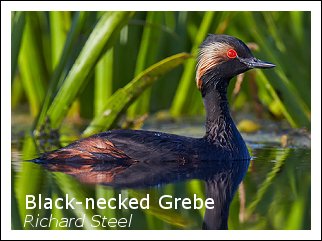 Barrie lives now in Crosby Merseyside and almost every morning from 7:00am, sometimes earlier, can be found ensconced at the top of a sand dune recording the passage of (land-based) birds along the coast - species and numbers thereof. These data are then entered onto a rather splendid website devoted solely to viz.mig - https://www.trektellen.nl. Barrie's personal data can be seen by clicking here. Different strokes for different folks! Barrie lives now in Crosby Merseyside and almost every morning from 7:00am, sometimes earlier, can be found ensconced at the top of a sand dune recording the passage of (land-based) birds along the coast - species and numbers thereof. These data are then entered onto a rather splendid website devoted solely to viz.mig - https://www.trektellen.nl. Barrie's personal data can be seen by clicking here. Different strokes for different folks!Barrie is hoping to join us on one or two of our trips - especially to Lunt Meadows - only a few miles from his home. He plans once again to go camping in the Shetlands during October in search of rare vagrants and hopefully he'll be sending us emails of his autumnal adventures. They were well received last year Baz!! Today (27th) we enjoyed a mornings birding over at Woolston Eyes and those that hadn't already done so were able to add Sand Martin (5) and Chiffchaff to their year list. A Cetti's Warbler again sang briefly from the reeds just below the first raised viewing platform from where we added the usual selection of wildfowl to the day list - Tufted Duck, Shoveler, Gadwall, Teal etc. and also the first Black-necked Grebe we'd seen this year. More Grebes were on view from the Morgan hide, so probably around six have now returned, a small flotilla of eight male and three female Pochard glided into view as we watched the Grebes (someone's going to be disappointed!) whilst on the feeders, Blue and Great Tits, Greenfinches plus half a dozen Bramblings coming into full breeding plumage reminding us that Winter can still have a cold sting in its tail. species recorded at Woolston Eyes - 27th March 2019.  18/03/2018...... A wild day on the Wirral 18/03/2018...... A wild day on the WirralIt's not often that we make last minute changes to our field trips, I can't remember more than a couple of occasions over the past 45 years but on Saturday (16th) the weather forecast for the southern Lake District was so bad that we decided to, re-schedule Leighton Moss for April and instead travel over to Burton Mere Wetlands. 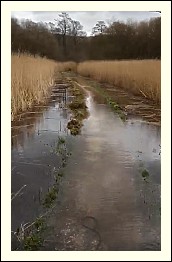 This meant that we avoided the worst of the impending storm and also a total of at least 3 hours travel time there and back, mainly on the M6. Additionally we already knew the paths at Leighton were flooded in mid-week so they could only have become worse (right). This meant that we avoided the worst of the impending storm and also a total of at least 3 hours travel time there and back, mainly on the M6. Additionally we already knew the paths at Leighton were flooded in mid-week so they could only have become worse (right).So it was a small and very select group that met up in Lilac Avenue for the journey west to the Wirral peninsula! Heavy rain to start with but the sun actually appeared as we approached our destination, although it was very, very windy; conditions that prevailed for the rest of the day - occasional sunshine and heavy, but short lived, rain showers. A good start to proceedings as we drove down Puddington Lane and came across a group of 24 Egrets feeding in a sheltered field. I did a quick count and assumed they were all Little Egrets but I was later told the two Cattle Egrets were often to be found amongst them. Staff outnumbered visitors at the reception centre but, most importantly, they'd got the coffee on, so we enjoyed a cup as we set up the 'scopes and began scanning the reserve. This Friday 22nd March it's our final indoor meeting of the season before the AGM. We'll be welcoming back David Tolliday who will be telling us all about "Overseas Travel with a Wildlife Camera".
Thanks for your reports Ken. Our trips to WWT starting at Slimbridge on the 7th of February the weather was overcast and windy thankfully no rain unlike the day before and the day after it rained a lot and was windier. It did not deter us from seeing the following birds.
Ten days later we visited Caerlaverock WWT 17th/18th Feb . Not having much luck with the weather, raining windy and a bit cool again, out we went and had a reasonable two days birding.
Winter returned with a vengeance today. Gale force winds and heavy rain to begin with, followed in the afternoon by sleety snow and eventually a flash of lightening ushered in a fierce hail storm as the temperature dropped rapidly from 7.0 to 2.5C. This though didn't deter the indefatigable Bob Groom who's persistence was rewarded with Tatton's first Sand Martin of the year over the main mere! .......... I was amazed how it kept flying in the atrocious conditions. I retreated into my car during the worst of it but as the sun came out again, there it was still criss-crossing the mere. Just hope it manages to find enough insects to survive this extreme weather........ This follows on from Bob's first Sand Martin of the season at Woolston Eyes and a count of no less than 25 yesterday over Marbury Park's Budworth Mere. So, despite the conditions, it's officially the first day of the KOS Spring! 7/3/2019...... A great morning at Woolston Eyes Ignoring a less than encouraging weather forecast a small group of seven mid-weekers travelled over to Woolston for a couple of hours birding on Wednesday morning (6th). Crossing over the bridge onto the reserve we were greeted by a Song Thrush in full early Spring song perched in the bare branches at the top of an ash tree 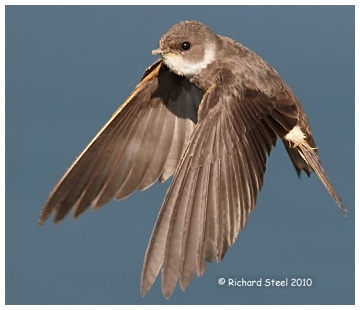 - beautiful and a good start to the day. - beautiful and a good start to the day.From the raised viewing platform all the usual suspects plus a Water Rail scuttling across the wide ride that's been cut through the reedbed opposite whilst just to one side the explosive song of a Cetti's Warbler - now quite commonplace here at Woolston with a number of breeding pairs - perhaps someone could send us a couple over to Knutsford Moor. Please! Bob Groom was a little behind the rest of the party as we walked to the Tower hide and, when he caught us up, was justifiably quite delighted to report that he'd had a Sand Martin as he'd made his way over. The first for any KOS member and a first this year for the reserve - nice one Robert!! Elevenses were taken in the comfort of the Morgan hide, bolstered on the day by Jude's excellent home made picked onions - I hope you save some for the Christmas party Jude! A reminder that it's time to renew your Woolston permit or apply for one if you've never had one previously. Click here - permits.
By the time you read this it's possible that storm Freya will be upon us as it powers in from the Atlantic Ocean, not good news for the very early migrants that arrived during the recent mild spell when a temperature of 21.2C was 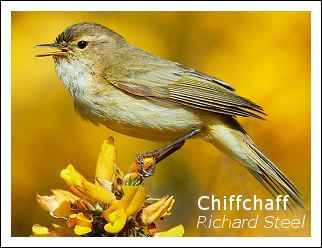 recorded in the south of England - the warmest Winter day ever recorded in the British Isles! recorded in the south of England - the warmest Winter day ever recorded in the British Isles!Wheatears, Sand Martins and Chiffchaffs have been seen already in places such as Anglesey, Burton Mere and Marbury; none at Tatton or Rostherne as far as I know but KOS member Karina Stanley heard a singing Chiffchaff yesterday (3/3) by the River Mersey in Didsbury. In Mobberley singing Skylarks are back along Smith Lane and Hobcroft Lane but, as yet, no displaying Lapwings although I expect them to return on schedule this coming week in the big fields opposite Smith Lane farm, their favourite location; this year growing Winter wheat - so they may stand more of a chance than last year. In two weeks time Saturday (16/3) it's our March field trip up to Leighton Moss meeting at the reserve around 10am or 08:30am in Lilac Avenue. We'll be looking for Sand Martin, Marsh Harrier, Marsh Tit, Bearded Reedling and, of course, booming Bitten! Please note that our April Field Trip has been changed from Saturday 20th April to Sunday 14th April to avoid the Easter weekend. 19/2/2019...... Very early Summer migrants We're enjoying spring-like weather at the moment as strong southerly winds sweep up all the way from Africa bringing us daytime temperatures as high as 14 ° C. A Red-rumped Swallow and one of our own Barn Swallows were both seen in South Wales last week, a House Martin was recorded today (19/2) on Anglesey and Bob Groom tells me a Sand Martin on Saturday (16/2) was the earliest ever recorded in the Cheshire and Wirral 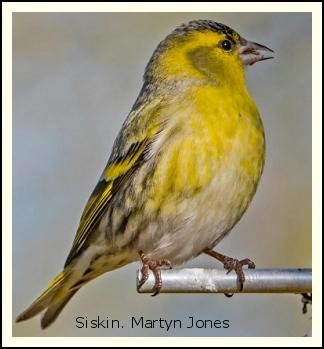 recording area! recording area!My request for volunteers to help with the Big Farmland Bird Count organised by the Game and Wildlife Conservation Trust met with a lukewarm response which was a great pity. A list of farms who had asked for help from competent birders was extensive with a large number in and around the Northwich / Middlewich area. This is an ideal opportunity to open a few doors and gain access to some new birding areas - I'll be twisting a few arms next year. As it was, just Bill Killey and I took part, and last Wednesday (13/2) visited Shipbrook Hill Farm, Whatcroft owned by Simon Bennett and home of Riverside Organic, a family run farm, wholesalers, farm shop, and cafe. The farmland is managed as stipulated in Natural England's Higher Level Stewardship scheme. Bill and I chose a field just down the road from the farm - flat and very damp running alongside the River Dane and being managed with Lapwings in mind. The first birds we saw as we approached the field were Curlews, a flock of 21 - so we started the clock there and then! An area of open water and juncus reed in the centre of the field held 6 Mallard and 13 Teal, a Song Thrush was singing from a roadside ash tree and, as we left, a Chaffinch spluttered into song - the first I've heard this year. 19 species and one Brown hare was a very satisfactory total given the 30' time limit. The annual late Winter increase in visitors to our feeders is underway, the resident Goldfinches have been joined by up to six beautiful little Siskins and yesterday three female Reed Buntings. No sign yet of Redpolls or Bramblings but I'm hoping we'll get some soon - other KOS members have reported both species in their gardens recently. This Friday (23rd) it's our February indoor meeting when Ashley Grove will be telling us all about "Trinidad and Tobago: Home of the Hummingbird". As usual 7:45pm for an 8pm start in the Jubilee Hall. 12/2/2019...... A weekend of contrasts Over the years I've slowly built up a modest collection of bird books, almost all concerning British birds. I have travelled abroad a few times but never been able to work up much enthusiasm for the species to be found in those far flung places. We've been to New Zealand five times but I've never seen a Kiwi! I'm never happier than when I'm 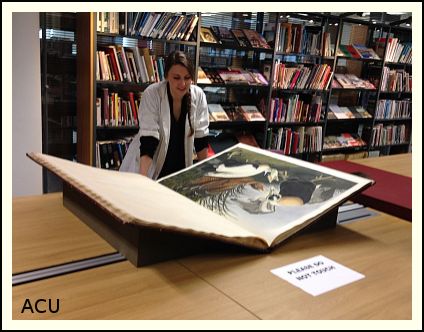 out birding in the UK - especially the leafy lanes of Cheshire. So, naturally, it's the books of Thomas Alfred Coward that I value most and I have all his published works. They're not expensive, I think my copy of "The Birds of Cheshire" published in 1900 cost the most - about
£
80. out birding in the UK - especially the leafy lanes of Cheshire. So, naturally, it's the books of Thomas Alfred Coward that I value most and I have all his published works. They're not expensive, I think my copy of "The Birds of Cheshire" published in 1900 cost the most - about
£
80.Despite this narrow spectrum of ornithological interests I've always found other people's books, if not their birds, fascinating; especially rare antiquarian examples and none more so than Audubon's iconic "Birds of America" - the four volume "double elephant" portfolio published in the mid 19th century each measuring 39"X26" with a total weight of 200lbs!. They're worth a little more than any of Coward's! In 2010 a set of the four volumes were auctioned for $11.5 million, equivalent to $13.2M today. I knew that the Liverpool Central Library owned a set and one was always on display in a glass case, each volume in turn and a new page revealed once a week. It was always my intention to travel over for a look but never got round to it, but when it was announced a few weeks ago that a special series of viewings were being arranged of not one but two volumes - out of their glass cases and laid out in front of you with staff on hand to relate the story of their arrival in Liverpool and answer questions about their conservation (past and future) it was an opportunity not to be missed. So on Saturday (9th February) Olwen and I headed west to Merseyside and the centre of Liverpool; just one navigation error when we ended up driving through the sleepy suburb of Wavertree not a place in which to linger! We finally arrived with no further mishaps at the appropriate location, a much more salubrious spot with the library sandwiched between the World Museum and the Walker Art Gallery opposite St. John's Gardens and the Bedlam Paintball Emporium! Just a single Lesser Black-backed Gull further up the mere and a few Goldeneye, there's been no late winter build up as yet. Elevenses were taken in the Allen hide overlooking Melchett Mere whilst watching a small gathering of waterfowl including Coot, Moorhen, Mallard, a dozen or so Wigeon and a pair (or is it two) Egyptian Geese. Our return route took us around the far side of Melchett close to the reedbed where Tony E. and Patch diverted into the reeds themselves and managed to put up a few Common Snipe and no less than 10 Jack Snipe that flew only a few yards before diving back into the reeds in their characteristic manner, unlike their bigger cousins that invariably "tower" away and leave the area completely. We left the park via "Beech Walk" and were lucky enough to bump into the previously reported mixed flock of Chaffinches and Bramblings. A respectable total of 49 species during a very pleasant mornings birding - thanks to all who were able to come along and help me celebrate my 75th birthday!!
6/2/2019...... Cold snap brings us more Winter visitors Topsy-turvy weather over the past couple of weeks, 7 ° C yesterday and 6.5 ° C today, in marked contrast to last week when the temperature remained below freezing on Thursday (31st) and dropped to -5 ° C in the early hours of Monday this week (4th). More Redwings and Fieldfares have appeared in our area, Jayne Davies tells me that she had large numbers of Redwings on Sunday (3rd) when driving into Tatton Park and the following morning (4th) a large mixed flock of Redwings, Fieldfares and Starlings fed amongst the sheep in a field along Smith Lane in Mobberley. Also in the village singing Song and Mistle Thrushes, the latter were very active defending their chosen nest sites from one another - nice to see more than one pair of these early nesters. Goldcrests are in song, 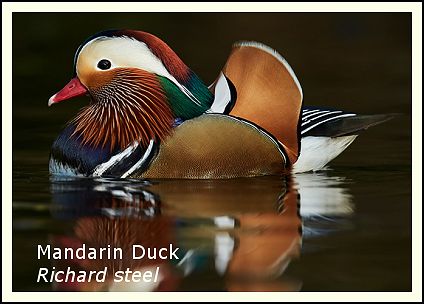 hidden away in the conifers surrounding Mobberley Church and some of the village's larger gardens. hidden away in the conifers surrounding Mobberley Church and some of the village's larger gardens.We welcomed back the first Siskins of the Winter to our feeders last Saturday when a male and female appeared on the sunflower hearts. Certainly not the first though, Geoff and Sheila Blamire had Siskins and Redpolls in their Mere garden on Sunday the 27th during the Big Garden Birdwatch. Steve Collins hosted both species two weeks previously in his Knutsford garden. The Manchester Birding Forum reports Brambling this morning (6th) along Beech Walk in Tatton. Park ranger Darren Morris had no less than 40 Mandarin Ducks in front of the Higmere Plantation on the Park's main mere (1/2). I thought this must have been a record for Cheshire but Hugh Pulsford tells me he has previously had a flock of c.100 on the lake in Alderley park where a nest box contained 24 eggs - all of which apparently hatched out! An interesting text today from Darren who has watched (for the past few weeks) 15 to 20 Cormorants herding young carp into the shallows of the lagoon at the north end of Tatton mere. I've seen film of Pelicans doing this but a quick search on the internet revealed that other members of the Cormorant family indulge in this cooperative exercise in other parts of the world. So plenty to look forward to on Sunday (10th) when our February field trip will be to Tatton. Meeting up at 9:00am in the Dog Lodge layby on Mobberley Road. Tony Ellis is the trip leader.
28/01/2019...... The Big Garden Birdwatch Cool but dry weather over the weekend when we again teamed up with The Friends of Knutsford Moor (Saturday 26th) and The Friends of the Heath (Sunday 27th) to lend a hand with the RSPB's Big Garden Birdwatch. 8C at 9:00am on Saturday morning as we gathered on the Moor. 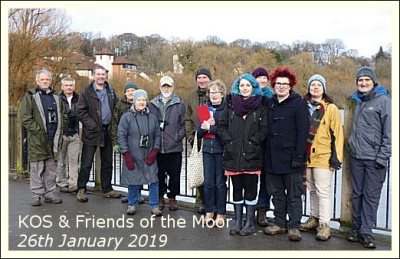 There was a good turnout of Knutsfordians together with three visitors from Stockport, it was just a pity that there were more people than birds! Still it was rewarding to be able to point out species such as Redwing, Nuthatch and Goldcrest etc. to folk who'd never seen them before. 28 different species in all, 3 up on last year but 7 less than in 2017. All recorded in one hour - the time allotted for the annual exercise. There was a good turnout of Knutsfordians together with three visitors from Stockport, it was just a pity that there were more people than birds! Still it was rewarding to be able to point out species such as Redwing, Nuthatch and Goldcrest etc. to folk who'd never seen them before. 28 different species in all, 3 up on last year but 7 less than in 2017. All recorded in one hour - the time allotted for the annual exercise.Just 19 species the following morning on the Heath; despite the later start it was 3 degrees cooler at a chilly 5C with gale force northerly winds making it feel even colder. Although the two locations are about the same size the Heath suffers from not having an area of water within its boundaries and so misses out on the waterfowl to be found on the Moor Pool (although we "nearly" had an Egyptian Goose that passed low over the Heath without landing - that wouldn't feature on many garden lists!). Despite its limitations the Heath is a pleasant place to explore on a windy winters morning, numerous paths criss-cross the woodland making it very popular with local families walking their dogs and the shelter provided by the trees meant the small birds weren't affected by the weather and Blue, Great and Coal Tits were all in song - a gentle reminder that Spring's just around the corner (although the weather forecast gives snow for tomorrow and last year "The Beast from the East" didn't arrive until late February!
On Friday (1/2) it's the CAWOS February meeting at 7:45pm at the Catholic Church on Tatton Street NB Some people are still getting CAWOS and KOS mixed up! KOS is the Knutsford Ornithological Society our local bird club and the "owners" of this website. CAWOS is the Cheshire and Wirral Ornithological Society - the county Society. Some KOS members are members of both.
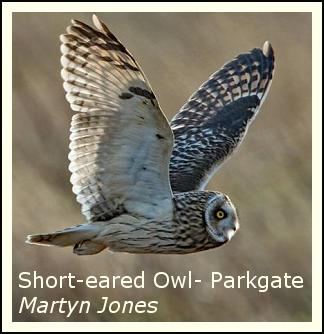 and quite treacherous so it came as no surprise that the paths were closed to visitors, even the short stretch to the first viewing screen where we'd hoped to find the Bearded Reedlings. and quite treacherous so it came as no surprise that the paths were closed to visitors, even the short stretch to the first viewing screen where we'd hoped to find the Bearded Reedlings.Despite this disappointment, and the fact that the main pool was also iced over, we spent the best part of an hour in the reception building enjoying crystal clear views across the reserve to the Connah's Quay power station and up to the snow covered Welsh mountains in the distance. The RSPB wardens had the wood burner going full tilt and the filter coffee on offer was most welcome - all very civilised! Pink-footed Geese passed to and fro high over the reserve whilst in the distance a small flock of Whooper Swans grazed alongside more Pinkfeet, Greylags and Canada Geese. On then to Parkgate for the high tide of 10M. Many others had also made the trip and the car park at the old baths was chock-a-block, we managed to squeeze in and made our way to the sea wall where Sheila Blamire was nicely ensconced with a clear view across the estuary. The high tide was due at 12:36pm but it soon became apparent that the incoming water was never going to reach the sea wall, conditions on this occasion were just not in our favour. Fieldfares have been conspicuous by their absence so far this Winter but I had 12 yesterday in Mobberley and Bob Groom counted 61 flying over Queensway at lunchtime. A busy weekend ahead starting this evening (Friday 25th) - Friday 25th January... KOS indoor meeting - "North Norfolk Here I Come" with Jim Almond Saturday 26th January - Big Garden Birdwatch with the Friends of Knutsford Moor. 9am to 10am on the Moor. Sunday 27th January - Big Garden Birdwatch with the Friends of Knutsford Heath 11am to noon on the Heath.
It was a real Winters day last year (21 January 2018) for our annual Winter Wildfowl Watch at the Allen hide - overlooking Melchett mere in Tatton Park. More benign conditions for this years event on Sunday (13th) with a temperature of 10 ° C, although a very strong westerly 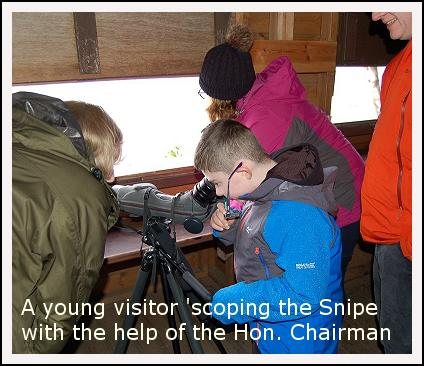 wind made it feel a little cooler. wind made it feel a little cooler.10 members arrived to give a hand during the morning, including Yvonne and Darren Morris who once again provided tea, coffee, biscuits and a supply of hot water - essential ingredients with which to tempt people in! We were surprised that given the more agreeable weather there were so few people passing by, but nevertheless with the promise of free refreshments we were able to accompany a steady stream of visitors down to the hide throughout the morning.Amongst the 31 species seen or heard there was nothing unusual but, with the use of member's 'scopes, things like Cormorant, Black-headed Gull, Coot, Mallard, Shoveler, Wigeon, Moorhen, Little Grebe, Great Crested Grebe, Pochard, Goldeneye and Common Snipe could be pointed out to our guests. Alan Gillespie, a long time friend of the KOS, again paid us a visit and alerted us to the fact that, as last year, a Kingfisher was on view along the channel connecting Melchett and the outlet stream from Tatton Mere. A 'scope was quickly set up there and passersby were able to view a species they'd previously only seen on TV! Most visitors were local to the area and from the positive comments received I suspect we may see some of them again at one of our coming indoor meetings or outdoor field trips. Thanks to all concerned for their help in making this event such a success - we must do it again sometime! Also in the park Roger Barnes tells me that Grey Herons can be seen perched high in the alder trees of Higmere plantation, staking out their claims to the most favourable nest sites prior to the breeding season, which is now upon us - young birds have been seen as early as February at some locations in the past. On his way to the Allen hide Alan Gillespie walked along Beech Walk, next to the golf course, and reports seeing Brambings feeding on the beech mast - the first I've heard of in our area this winter. There are some high Spring tides next week - around 10 meters on the 22nd, 23rd and 24th. The RSPB will be putting on a special event on the 23rd. Wednesday 23rd January - Parkgate High tide Birdwatch (RSPB). 10.30am-2.30pm, Price: Free. In celebration of the RSPB Dee Estuary reserve's 40th anniversary, join us at Parkgate Old Baths for the awe-inspiring spectacle of a high tide flooding the vast salt marsh, potentially reaching the old sea wall. The marsh at Parkgate is one of the best wetland habitats in the northwest, and when flooded by an incoming tide, the wildlife which lives here is pushed closer, with chance of seeing the great range of ducks, geese, wading birds and egrets in big numbers as they are driven upstream by the rising tide. A range of birds of prey take advantage of mice and voles flushed from the grasses; hen and marsh harriers, peregrines and merlins all spend the winter months on the estuary and this is one of the best places to watch them, plus short-eared owls if we're really lucky. So why not venture out to try witness all the drama. Low pressure and a westerly wind will help push the tide and wildlife in close. There is free public parking at the Old Baths car park (CH64 6RN) at the north end of The Parade, and the Wirral Country Park car park on Station Road (CH64 6QJ). There are public toilets at Mostyn Square in the middle of The Parade, and a number of pubs and cafes. High tide (10.0m/32.8ft) at 12.36pm.
07/01/2019...... January field trip to Connah's Quay
Luckily Frank was in his usual unflappable mode and soon had us back on track. We were late but only by a few minutes. 75 years ago chaps like him would have been sat in the tattered remains of the fuselage of a crippled Lancaster bomber calmly guiding the pilot back to safety at some aerodrome on the flatlands of Lincolnshire! Anyway, suitably embarrassed, we eventually landed to hoots of derision from the rest of the KOS Crew!! High tide was at 11:00am so we made our way immediately to the tower hide at the far end of the reserve, Chaffinch, Linnet and Brambling, seen from the cars, were early additions to the day list as we made our way along the track running parallel with the River Dee. Earlier in the morning we'd seen huge flocks of Pink-footed geese passing overhead as we approached Connah's Quay, a few more were seen from the hide but here Canada Geese predominated, a sizable flock grazed in front of us accompanied by a few Greylags and two difficult to find Barnacle geese. This coming Sunday (13th) we'll again be at the Allen Hide, overlooking Melchett mere, in Tatton Park from 11am until 1pm for the annual Winter Wildfowl Watch in conjunction with the Park Rangers. Always good fun and we're hoping that refreshments will again be available but this depends on what Darren can scrounge!!
30/12/2018...... Christmas Walk A pleasant enough day on Friday (28th) for our annual Christmas walk around Budworth Mere / Haydn's / Neumann's etc. - overcast but dry with a maximum temperature of 12 ° C. It was nice to see our Hon. Sec. Derek back out in the field and in great form! and also Hon. Treasurer Frank who survived a 10 hour drive up from Kent the previous day - sheer weight of traffic with cars queuing in the slip roads up to the services on the M25 and M6; how on earth are we to cope in the future when all these vehicles need their batteries 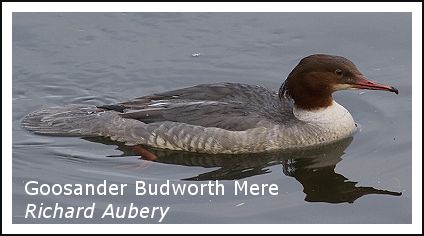 charging when we're all electric? charging when we're all electric?Our route took us from the Witton Bridge car park up to Haydn's pool, along to Budworth Mere then over to Neumann's Flash on our way back to the cars. Dunnocks, Great and Blue Tits were all in song as we approached Butterfinch Bridge, no Cetti's Warbler this year but a Water Rail called briefly from deep inside the reedbed upstream from the bridge. Haydn's Pool was disappointing; it's currently overgrown with little water to be seen, but we did tick off Stock Dove and Peregrine on the day list - the latter perched on a railing on the old ICI building, not in it's usual position on the chimney - you can't hide from the Hon. Chairman's Swarovski! Elevenses were taken at the viewing screen overlooking Budworth Mere. More to see here, the most obvious species on view were the Goosanders - no less than 29 birds, four full adult males but mostly "red heads" one of which was fishing in the shallows, just below the screen, where Richard obtained the image shown above. A second Water Rail was heard from here whilst out on the mere good numbers of Great Crested Grebes two of which were displaying. Over towards the sandspit were the gulls, Mainly Black-headed with a few Herring a handful of Lesser Black-backed and a single Great Black-backed. Other wildfowl included Shoveler, Tufted Duck, Little Grebe with a couple of Canada Geese and a lone Goldeneye. A Kingfisher flew low over the mere as we made our way along the waterside path and into the woodland. Approaching Neumann's we came across a small flock of finches predominately Green and Gold but alongside them a couple of Lesser Redpolls. More Wildfowl on Neumann's with Wigeon and Teal present in good numbers; across on the far side of the flash a flock of c. 200 Lapwings (but no Golden Plovers this time). Richard, Geoff and Sheila diverted to Pod's hide before returning to the cars and from there had a Snipe and great views of a Water Rail which was so close that Richard was able to capture this shot with his phone camera. In the foreground you'll see red roses left in memory of Pete "Pod" Antrobus and in who's memory the hide was erected. A poignant image and a reminder that for many people Christmas and New Year can be a very difficult time. Some up and coming dates for your diary. Friday 4th January.... The latest CAWOS meeting - Paul Hobson "Scotland" 7:45pm at the Catholic Church, Tatton Street, Knutsford.Sunday 6th January.... Our KOS January field trip to Connah's Quay. 08:30am at the Tatton Street car park or 09:20 at the entrance to the reserve. Hopefully the Twite flock has built up again this winter. Sunday 13th January... Wildfowl watch with the Tatton Rangers. 11:00am to 1pm at the Allen hide. Friday 25th January... KOS indoor meeting - "North Norfolk Here I Come" with Jim Almond Saturday 26th January - Big Garden Birdwatch with the Friends of Knutsford Moor. 9am to 10am on the Moor. Sunday 27th January - Big Garden Birdwatch with the Friends of Knutsford Heath 11am to noon on the Heath.
Greetings all. A lovely evening last Friday rounded off our 2018 meeting programme with festive spirits fuelled by a delicious food offering. This event is also our sole fund raising effort of the year; here is how we did on that front. A total of twenty one people attended the party; a figure lower than in previous years owing to a number of late cancellations from members felled by various bugs. Nevertheless, the evening was a great success on the financial as well as the enjoyment front, coming in the top three of KOS parties for money taken and profit recorded. The two occasions when slightly more was raised were years when we had guest lists of twenty eight. Based on the size of our gathering, it was the most financially productive party that we have ever had. Admission money at £ 7 per head raised £ 147.00 The raffle organised by Sue and Jacquie brought in £ 54.10 The bring and buy stall, followed by the end of evening auction, overseen by Sheila and Judith realised £ 54.40 Various donations totalled £ 53.00 This produced a total revenue of £ 308.50. Deducting modest buffet costs of £ 51.50 (all the offerings being subsidised in some way by the providers) gave a profit of £ 257.00 So a big thank you to all involved in our party, for supporting the raffle and the bring and buy, for providing the food and making donations. Also to Bob for organising a quiz and providing the prize. The sum raised will help keep the Society going and enable us to continue to attract quality speakers to our meetings. Frank Thanks Frank it looks as though we'll not have to post that begging letter to Jose Mourinho who's apparently leaving Old Trafford with a golden goodbye of £ 18 million!I've not received many sightings of interest since the last update. Bob Groom was at Rostherne on 11th December and had a flock of c.100 Pinkfeet flying over. In Mobberley along Pavement Lane two Little Owls have taken over the oak tree nest site used two years ago by a pair of Barn Owls. Blue, Great and Coal Tits have been in song for the past couple of weeks and were joined over the weekend by the local Dunnocks. Not long now to the shortest day and in the garden the daffodil leaves are beginning to emerge - Spring can't be that far away - or am I being a tad too optimistic? In his weather column in today's Times Paul Simons, who correctly predicted the arrival of the "Beast from the East" at the end of February, seems confident that were going to suffer something similar in the near future, possibly as soon as late December although more likely in mid to late January. It could run through to February with hard frosts, ice and snow - you've been warned! I've updated the trips and meetings page with three additional outdoor events. On December 28th we'll be having our Christmas walk around the Northwich Woodlands - Neumann's / Haydn's / Budworth Mere etc. meeting at the usual Witton Bridge car park at 09:45 for a 10am start. |
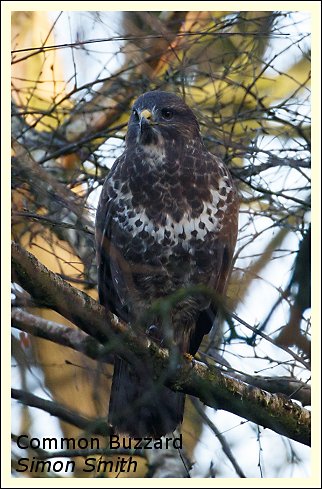

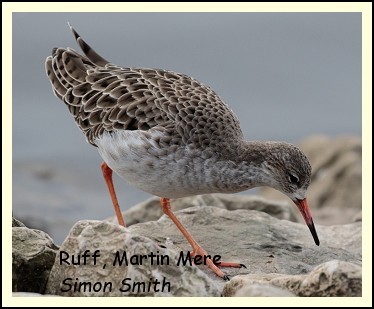 although there were fewer about this time - just a single Kestrel and a quite magnificent male Hen Harrier that was quartering the marsh as we made our way to the other hides. From Nel's hide we had good views of the usual Teal, Tufted Ducks, Shoveler, Pintail and Black-tailed Godwits plus thousands of Wigeon, the most numerous of the wildfowl species this year. There were only a few Curlew present this time around, a species that seems to be struggling more than most and a cause of great concern amongst naturalists.
although there were fewer about this time - just a single Kestrel and a quite magnificent male Hen Harrier that was quartering the marsh as we made our way to the other hides. From Nel's hide we had good views of the usual Teal, Tufted Ducks, Shoveler, Pintail and Black-tailed Godwits plus thousands of Wigeon, the most numerous of the wildfowl species this year. There were only a few Curlew present this time around, a species that seems to be struggling more than most and a cause of great concern amongst naturalists.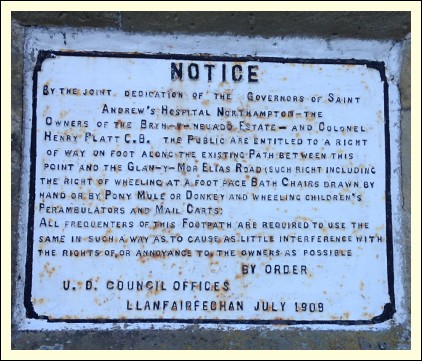 The Hon.Sec. put us onto a winter plumage Red-throated Diver and, not to be outdone, our Hon. Chairperson came up with two very late Sandwich Terns. A tight flock of 20 Turnstones flew in a short distance from where were watching and settled on the pebbles amongst the gulls - appearing to melt into the background such is the effectiveness of their winter plumage.
The Hon.Sec. put us onto a winter plumage Red-throated Diver and, not to be outdone, our Hon. Chairperson came up with two very late Sandwich Terns. A tight flock of 20 Turnstones flew in a short distance from where were watching and settled on the pebbles amongst the gulls - appearing to melt into the background such is the effectiveness of their winter plumage.
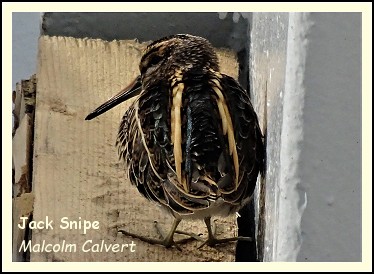
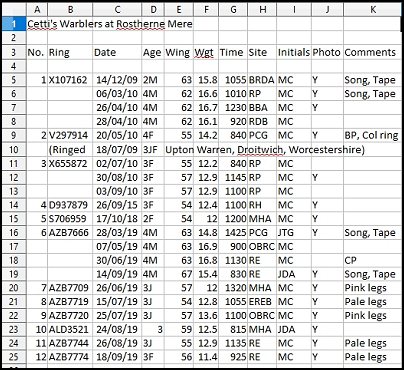 Regular visitors to Rostherne will have no doubt met Malcolm Calvert at one time or another. Malcolm is a ringer and a bit of a legend! He founded the South Manchester Ringing Group back in 1969 and began ringing the Reserve's birds in 1973 and up to the end of 2016 had ringed more than 18,000 birds of 73 species - a phenomenal effort. He has made a special study of Rostherne's discrete colony of Reed Warblers gathering data on 3,000 nests and ringed no less than 7,600. Tom Wall's "Aspects" volume (see below) has a full chapter (#15) written by Malcolm on his ringing exploits.
Regular visitors to Rostherne will have no doubt met Malcolm Calvert at one time or another. Malcolm is a ringer and a bit of a legend! He founded the South Manchester Ringing Group back in 1969 and began ringing the Reserve's birds in 1973 and up to the end of 2016 had ringed more than 18,000 birds of 73 species - a phenomenal effort. He has made a special study of Rostherne's discrete colony of Reed Warblers gathering data on 3,000 nests and ringed no less than 7,600. Tom Wall's "Aspects" volume (see below) has a full chapter (#15) written by Malcolm on his ringing exploits.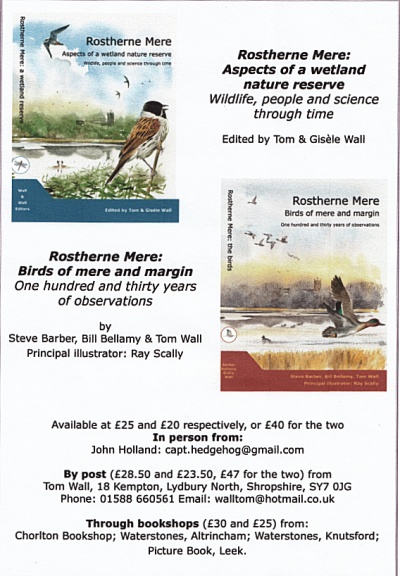 fear not the authors have done the right thing and written their particular sections with the intended audience in mind and as a consequence it's book that can be read from beginning to end without becoming overwhelmed. Tom's subtle sense of humour surfaces from time to time to time and I laughed out loud when he describes confrontations between trespassers and Jack Osborne (Keeper and Warden 1952 -72) - ".....three couples who were attempting to break one of the ten commandments and two couples who were doing so. On such occasions he told them that they had ignored several "no entry" signs and now a quick withdrawal was required!".
fear not the authors have done the right thing and written their particular sections with the intended audience in mind and as a consequence it's book that can be read from beginning to end without becoming overwhelmed. Tom's subtle sense of humour surfaces from time to time to time and I laughed out loud when he describes confrontations between trespassers and Jack Osborne (Keeper and Warden 1952 -72) - ".....three couples who were attempting to break one of the ten commandments and two couples who were doing so. On such occasions he told them that they had ignored several "no entry" signs and now a quick withdrawal was required!".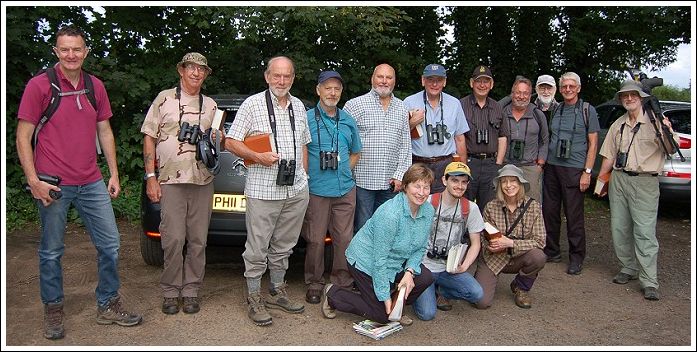
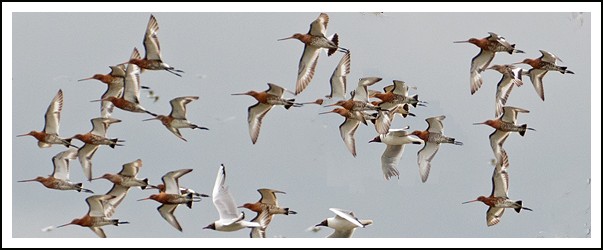
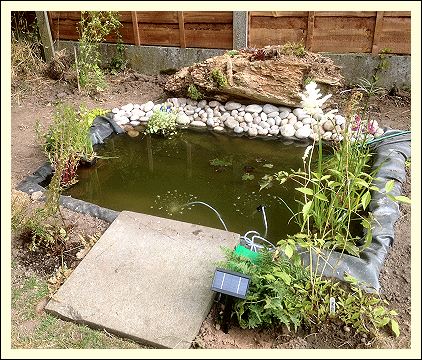 or probable breeding. They have nested in our area again a number of times but I suspect, for one reason or another, there's been a decrease since the Atlas survey work, so I was pleased to see another Hobby last Wednesday (3/7) in Mobberley following on from the bird hunting at the same location on 28/6. Later the same day Darren Morris had one in Tatton's deer park, perhaps the same bird as the two sites are only a short distance away, given the speed at which the species flies. A couple of days later Bob Groom spent three hours searching for Hobbies in Mobberley at the spot where we had the Yellow Wagtails recently; great views to the south from this relatively high location but he had no luck, although he did have Sparrowhawk, Buzzard, Kestrel and, of course, the wagtails.
or probable breeding. They have nested in our area again a number of times but I suspect, for one reason or another, there's been a decrease since the Atlas survey work, so I was pleased to see another Hobby last Wednesday (3/7) in Mobberley following on from the bird hunting at the same location on 28/6. Later the same day Darren Morris had one in Tatton's deer park, perhaps the same bird as the two sites are only a short distance away, given the speed at which the species flies. A couple of days later Bob Groom spent three hours searching for Hobbies in Mobberley at the spot where we had the Yellow Wagtails recently; great views to the south from this relatively high location but he had no luck, although he did have Sparrowhawk, Buzzard, Kestrel and, of course, the wagtails.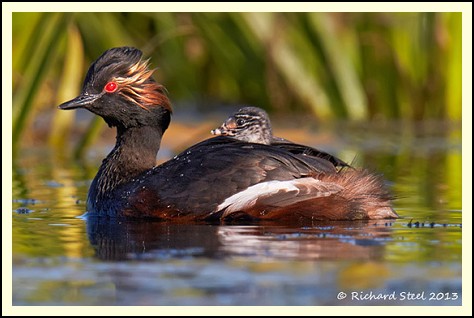 much. We spent an enjoyable morning at Woolston Eyes on Thursday, where the Black-necked Grebes seem to be doing well. It's difficult to determine the number present but 22 adults is the latest estimate and these have produced 8 or 9 broods. We watched two pairs carrying their tiny chicks on their backs; this is the safest place for them as the reserve is having problems with Lesser Black-backed Gulls predating any youngsters they come across. Pochard have been particularly badly hit, Brian Martin told me that up to 12 broods have been lost - although yesterday two new families were seen during a survey, we saw only one Pochard during the morning. A Lapwing was incubating four eggs on one of the islands in front of the Morgan hide, they hatched successfully yesterday. Also from this hide a constant stream of Swifts feeding over the reeds, presumably birds that are nesting in Warrington, no hirundines though, with the exception of a single House Martin. There was some song from the resident warblers - Chiffchaff, Blackcap, Common Whitethroat and one Sedge Warbler. Reed Warblers could be seen feeding in the phragmites when viewed from the top of tower hide - adult birds and their wing-shivering fledglings in food soliciting mode. David Bowman has produced a nice video showing some of the avian activity during the Spring and early Summer -
much. We spent an enjoyable morning at Woolston Eyes on Thursday, where the Black-necked Grebes seem to be doing well. It's difficult to determine the number present but 22 adults is the latest estimate and these have produced 8 or 9 broods. We watched two pairs carrying their tiny chicks on their backs; this is the safest place for them as the reserve is having problems with Lesser Black-backed Gulls predating any youngsters they come across. Pochard have been particularly badly hit, Brian Martin told me that up to 12 broods have been lost - although yesterday two new families were seen during a survey, we saw only one Pochard during the morning. A Lapwing was incubating four eggs on one of the islands in front of the Morgan hide, they hatched successfully yesterday. Also from this hide a constant stream of Swifts feeding over the reeds, presumably birds that are nesting in Warrington, no hirundines though, with the exception of a single House Martin. There was some song from the resident warblers - Chiffchaff, Blackcap, Common Whitethroat and one Sedge Warbler. Reed Warblers could be seen feeding in the phragmites when viewed from the top of tower hide - adult birds and their wing-shivering fledglings in food soliciting mode. David Bowman has produced a nice video showing some of the avian activity during the Spring and early Summer - 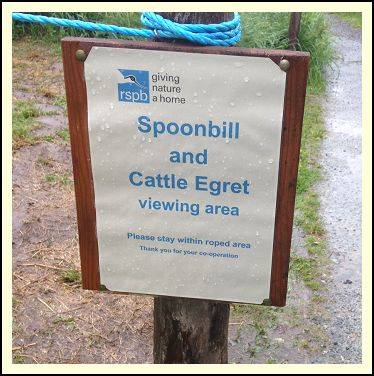 The weather here wasn't too bad, some heavy showers and it was quite windy, but there was plenty of activity out on the pool in front of the reception building and beyond.
The weather here wasn't too bad, some heavy showers and it was quite windy, but there was plenty of activity out on the pool in front of the reception building and beyond.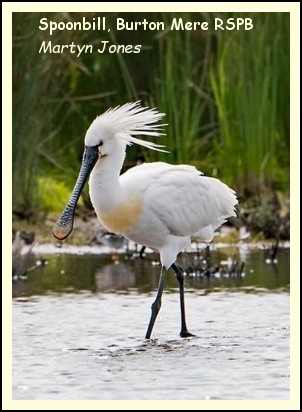
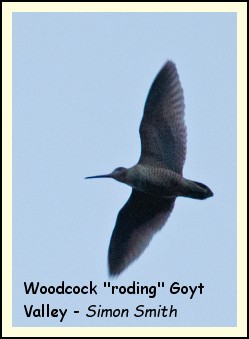 the others preferred the road itself running alongside the reservoir (the road not the KOS members!).
the others preferred the road itself running alongside the reservoir (the road not the KOS members!).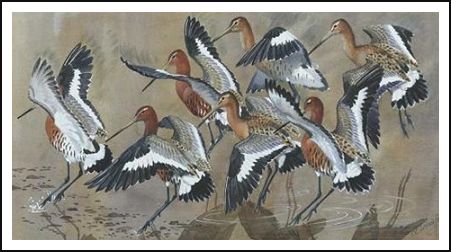 and Lillian's hides we enjoyed a lunchtime break in the excellent restaurant before walking down to the Causeway hide where we added Oystercatcher, Great Crested and Little Grebe to the day list and watched a family of four Otters enjoying a fishing expedition in the centre of the lake. The first I've seen at Leighton Moss despite so many visits over the years. No Bitterns (only one male this year) or Bearded Reedlings, although others had heard them calling earlier in the day.
and Lillian's hides we enjoyed a lunchtime break in the excellent restaurant before walking down to the Causeway hide where we added Oystercatcher, Great Crested and Little Grebe to the day list and watched a family of four Otters enjoying a fishing expedition in the centre of the lake. The first I've seen at Leighton Moss despite so many visits over the years. No Bitterns (only one male this year) or Bearded Reedlings, although others had heard them calling earlier in the day.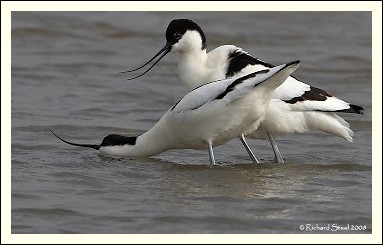 Most species were hunkered down due to the ongoing gale, but a female Marsh Harrier spent most of the morning quartering the reserve, her progress marked by potential victims taking briefly to the air. A passing Peregrine though caused much more consternation and generated a blizzard of activity!
Most species were hunkered down due to the ongoing gale, but a female Marsh Harrier spent most of the morning quartering the reserve, her progress marked by potential victims taking briefly to the air. A passing Peregrine though caused much more consternation and generated a blizzard of activity!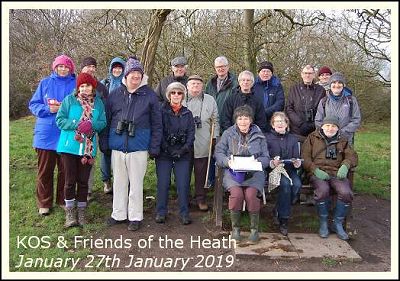
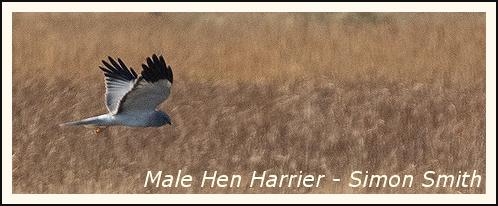 Nevertheless there were plenty of good birds to be found and those that appeared gave us good views. Up to five Marsh Harriers were in the air together, Male and female Hen Harriers caused much excitement as did the hunting Short-eared Owls - three at one stage with one posing photogenically on an old fence post out in the estuary, perhaps just too far away for the multitude of photographers after that killer image!!
Nevertheless there were plenty of good birds to be found and those that appeared gave us good views. Up to five Marsh Harriers were in the air together, Male and female Hen Harriers caused much excitement as did the hunting Short-eared Owls - three at one stage with one posing photogenically on an old fence post out in the estuary, perhaps just too far away for the multitude of photographers after that killer image!!